










 BY KEITH BURBANK
BY KEITH BURBANK
Birds, animals, and neighbors will miss Mr. and Mrs. Murray if the Planning Commission approves development of 2051 Third Street. Mr. and Mrs. Murray are two trees, so named by local schoolchildren who track their status and health. The trees will be cut down as part of Raintree Partners’ proposal to build 93 rental units in Dogpatch.
Those opposed to the project hired attorney Steven M. Williams to represent them before the San Francisco Planning Department, claiming that the drawings submitted to the department were inexact. “It was inaccurate by a significant amount,” said planner and preservation technical specialist Doug Vu of the Planning Department. The drawings, called “elevations,” were imprecise relative to the adjacent
DEVELOPMENT page 14
parking passes for caregivers responsible for a child or children under 12 years old. The permits are available regardless of where the nanny lives or where their car is registered.
There’s a hitch, however. Permitseekers must secure approval from at least 10 households on blocks where there are 20 or more residential units, provide birth certificates for the children for whom care is being provided, as well as proof of residency and other paperwork. On streets with 19 or fewer residences, at least half the addresses must agree to the permit system. Once authorized, the transferable parking permit is counted as one of four allowed per address, at a cost of $109
 BY BRIAN RINKER
BY BRIAN RINKER
Last month, Diane Wesley Smith called it quits on the steps of City Hall, officially ending her bid for District 10 Supervisor.
“Why run when we have good candidates with the same agenda as mine, to support District 10 and put the people first,” said Smith, who endorsed three supervisorial aspirants during a press conference after she signed the papers that ended her campaign. “I support Tony Kelly, Marlene Tran, and Ed Donaldson.”
Smith said she worried that too many candidates might confuse voters. She hoped her dropping out would fend off the chaotic political scrum that happened during the 2010 election, when more than 20 people ran for supervisor. Smith called her strategy “The United Front for District 10.”
“It is a united front against Malia Cohen,” said Kelly, stressing the theme that District 10 residents should “vote for anyone but Malia.”
While Smith is out of the race, Marlene Tran is in. A longtime Visitacion Valley community activist, Tran ran for Supervisor in 2010, coming in fourth in the initial round of rankedchoice voting. Tran attended Smith’s City Hall press conference along with almost a dozen supporters, who chanted “thank you Diane” in unison during the conference.
“If Malia had been doing a good job nobody would be running,” said Tran, a retired teacher who spent 37 years working with immigrant children and adults. “This is going to be a heated race. More heated than last election.”
A staff member from 50+1 Strategies, LLC, a campaign consulting firm Cohen has engaged to handle her re-election, attended the press conference. “Simply criticizing Supervisor Cohen without offering positive ideas is both unproductive and unhelpful,” said Nicole Derse, a campaign spokesperson for Cohen. “We are confident that District 10 voters are smart enough to see through the rhetoric and vote to continue improving our neighborhoods.”
Kelly, Tran, Donaldson, and Smith all said that the district faces the same problems it did four years ago. For Bayview-Hunters Point and Visitacion Valley residents, the main concerns are
One of my dominant childhood memories is of my father’s constant quest to get something for nothing. He’d pile my three sisters, my mom and me into our station wagon and troll the streets for shopping center and bank openings offering free cookies, balloons, and plastic key chains. I’d eaten hundreds of those flower-shaped shortbread cookies with cherry-flavored jelly in the middle – the kind you only find at low-end receptions or bakery outlet stores – by the time I was ten.
My father’s pursuits have been made possible by the incredible bounty of free things our society spits out. Every minute of every day, somewhere in the United States, someone is giving away a complimentary cup, flashlight, calendar, or food item at a conference, “grand opening,” or street festival.
For a while I followed in my father’s footsteps, compulsively elbowing my way to the table of free snacks at Costco or Trader Joe’s, downing foul tasting samples of new beverages simply because they were gratis.
At one point I had two shoe boxes packed full of tiny bottles of lotions, shampoos, and conditioners collected from various hotels I’d stayed at. My wife put an end to my inherited hobby, by insisting I unload my boxes of potions and lotions, or at least get them out of the house. I resisted at first, but then decided to distribute my collection during my travels to less-wealthy countries. Whenever someone on the street asked me for money in Peru or India, I handed them a bottle of liquid soap. I’d usually get a smile in exchange, though one Nepalese woman demanded to know what use conditioner would be to her.
Recently I’ve been traveling to Niger, the planet’s poorest country. I asked my father if he could give me some of the pens he’d been collecting to give away, a request he took as a challenge to re-double his efforts to score freebies.
Each afternoon in Niamey, Niger’s capital city, after a late lunch of take-out food eaten in my room, I’d take a stroll around the hotel, carrying a Walgreen’s canvas bag of logoed pens collected by my father over a lifetime – I recognized a pen that I’d seen as a child, carrying the name of a bank that no longer exists – and a few Halloween candies stolen from my daughter Sara’s stash. The pens were soaked up like water in the desert: shop keepers, children, and beggars of all stripes were delighted to receive them. One 20-something woman in a cycle wheel chair, with baby strapped to her back and young girl at her side, chased me half-way down the hotel’s entry-boulevard, only to beam a thousand-watt smile after receiving two plastic pens.
Everyone was happy with the pen distribution; everyone but the street boys. These urchins, who ranged in age from perhaps seven to 10, complained if their pen was too plain, and always aggressively demanded more “bics.”
One afternoon I packed my bag as usual, and headed into the dusty streets. I was quickly approached by one of the more dogged boys, who’d glued himself to my side a few days previously in an attempt to score multiple pens. This time I quickly gave him a pen and a Tootsie Roll; after which I was immediately swarmed by a dozen boys, most dressed in rags, jumping, grabbing, yelling for pens. I tried passing them out, but soon I was overwhelmed, said “enough,” and walked away.
Followed, of course, by three of the boys, “Can I have a pen? Give me a pen? Can I have a pen? I didn’t get a pen,” the most aggressive pen worshiper chanted. “Just us three need a pen; we didn’t get a pen,” he repeated, even after one of his friends mistakenly flashed two of the pens he’d received a few moments ago.
“No,” I responded, “it is finished.” I ducked into a pharmacy. They were there when I left. I walked into a crowded street market, hoping they wouldn’t follow me. But they did.
“Can I have a pen? Give me a pen? Can I have a pen? I didn’t get a pen.”
Finally, I could take it no more. I spotted a man, sitting in an empty market stall, fingering his prayer beads. I motioned him over to me.
“Here,” I said, and emptied the entire contents of the bag into his willing hands – perhaps two dozen pens of various designs, along with an equal number of candies. He looked like he’d just received a handful of gold, and thanked me profusely. I dramatically shook out the bag, indicating it was completely empty, and walked away. The boys did not follow.
I felt liberated, ecstatic, and, guilty all at once. What lesson had I taught them? That they should be polite? That penniless children aren’t worth a few extra pens? And the man with the prayer beads, my own personal marabou, what of him?
I walked back to the hotel, exhausted. I lay down on the flimsy foam mattress. As I closed my eyes I saw them, there, next to my suitcase: more pens, dozens more pens.
This story was rst published in the View’s January 2007 issue.

Editor,
In 1946 I arrived on Potrero Hill and have used the 22-Fillmore since then. At that time it was an old streetcar with a cow catcher on the front. Sometime later they became modern streetcars, and then, as we have today, the electric trolleys. I’ve always lived within walking distance to my home from the 18th and Connecticut streets stop.
Now I’ll be forced to either walk up four hills, instead of one, or transfer at Rhode Island to take the 19 up to 20th and walk down two steep hills and the Carolina stairs, or transfer to the 33, I presume at 16th and Bryant, to get back to 18th and Connecticut streets as I’ve done for 68 years.
All this to make it more convenient for the people in Mission Bay. They not only get the 22-Fillmore, but the 10-Townsend, now the 10-Sansome. They also have the T-Line. What about the people who transfer from the current 22 to the 48 at 20th and Third? I guess the people in Dogpatch will have to transfer at 16th and Third to the T.
Once again Potrero Hill becomes the step-child.
Rose Marie Sicoli-Ostler Carolina Street

Riding home from celebrating my first book compadre riding shotgun our lids heavy with poems and tequila in beat-up sports car crawling towards Bernal Heights dawn a spider with a thousand legs of light
A black-and-white flashing triple strobes angry at Latinos riding around this hour of morn instead of heading to work pulled us over
Compadre and I exchanged glances as other encounters with billy clubs handcuffs broken ribs surfaced from our suddenly awake memories
Without license, nor any ID I proved my name by reciting a poem while badge 8601 dug my rhymes and followed along in my proud book
Then 8601 returned to patrol car while I winked at compadre thinking we’re cool with the heat so I never saw ol’ 8601 slide up my window like a snake put the 357 magnum to my temple the barrel cold as a pinpoint of ice
The gun trembled in his hand as his pressed through lips tighter than a chicken butt—You’ve a red warrant. Move and I'll blow your damn head off.
I slanted my eyes at him and replied, —Be cool. I'm not that bad a poet.



Artist and author Marilyn Yu is offering space in her 91-year-old Bryant Street building to fellow artists, designers, and small businesses under a program she calls “SHARED.” The facility features concrete floors, high ceilings, and natural light. SHARED is a, well, shared, creative work-space that also features workshops and
events, such as ukulele and sewing classes, screenwriting workshops, and a monthly collage party. Yu moved to San Francisco during the first dot-com boom in the late 1990s. After engaging in the art and urban planning scenes, in 2012 she bought her Bryant Street building with loans from the U.S. Small Business Administration, friends, family, and more than a handful of credit cards. SHARED opened
Over the past 15 years, San Francisco transit officials have devoted almost all of their planning efforts to get people out of their cars and into Muni to travel to and from downtown. If you want to go anywhere else — to Costco, visit your family or friends, other neighborhoods, or travel to the Peninsula — our transit officials and transit agency have nothing to offer but indifference or hostility. They don’t want you to get in your car and go to Costco, buying 36 rolls of toilet paper, 30 pounds of cat litter, and a 28-can case of V-8. They want you to get out of your car and go downtown to work!
This has got to stop. Transportation policies in the City have to again reflect the way San Franciscans actually live; the way policies did before our “forward-thinking” Transit First policy became the nightmare of a Transit- and Bike-Only policy.
Over the last 15 years, thousands of parking spaces – and their revenue
– have been lost. New developments are no longer required to create one parking space for each new unit. The effects of these policies are devastating to growing neighborhoods, like Potrero Hill, and will become worse as new, market-rate, housing is built.
Our transit policies have become a “war on motorists,” which has created collateral damage to thousands of other San Franciscans, including first responders, seniors and the disabled, merchants and their customers, families with children, and members of the faith-based community.
That’s why a broad-based coalition of merchants, neighborhood and labor activists, advocates for seniors and the disabled, and San Francisco Municipal Transportation Agency watchdog groups have come together to place a Declaration of Policy on the November 4, 2014 ballot for the purpose of Restoring Transportation Balance in San Francisco.
For more details, go to restore balance14.org.
its doors last year…As reported by the San Francisco Chronicle earlier this year, 151 Potrero Street, which has provided low-cost studio space for artists for almost 30 years, has been leased by Pinterest , which is subsidizing the artist studios. The co-working space, formerly Live Art Gallery, is now called Code and Canvas. Startups can rent office nooks or access to communal space for $200 to $2,400 a month; most artists pay $240 to $500 for a shared or private studio. Code and Canvas is home to roughly a dozen artists – including Calixto Robles, who was featured in last month’s View – and can accommodate up to 50 techies.
A state appeals court has greenlighted AT&T ’s plan to install the rest of its proposed 726 utility boxes on San Francisco sidewalks, rejecting opponents’ arguments that the City should have studied the environmental impacts on traffic, pedestrians, and the scenery. The four-foot-tall metal boxes contain equipment for high-speed Internet service; in 2011 they were approved by the San Francisco Board of Supervisors in a six to five vote. According to San Francisco Beautiful, which is leading the opposition, the boxes are eyesores and graffiti magnets, and will interfere with visibility for pedestrians and drivers. In response, last month the Board passed legislation to give residents more say in where the boxes can be placed, and require the giant telecommunications company to work with the City to make them more aesthetically pleasing. AT&T has countered with another lawsuit. It’s unclear if the legislation will fend off placement of a surfacemounted cabinet at the Missouri and 20th streets intersection, which many Hill residents oppose…The San Francisco Police Department’s Gang Task Force served a search warrant at the Hells Angels Motorcycle Club on Tennessee Street last month.
Officers arrested Charles Nucci in connection with an aggravated assault last year, in which several assailants wearing Hells Angels jackets allegedly attacked a victim in San Francisco.
After 14 years on Carolina Street, The Wine House has moved to the corner of Third and 26th streets. The Carolina Street lease was up for the retail, import, and wholesale business, and the building owner wanted to do something else with the space, according to David Netzer, president, The Wine House. Netzer was dedicated to staying in the neighborhood, and ultimately signed a 10-year lease at the 26th Street property. “It’s so much nicer inside,” he said of the new location. Hours are Monday to Friday, 10 a.m. to 6 p.m. and Saturday, 10 a.m. to 5 p.m. Like the old location, there are a couple of parking spaces in front of the entrance…American College of Traditional Chinese Medicine is celebrating 35 years on Potrero Hill.
The San Francisco Municipal Transportation Agency, together with District 10 Supervisor Malia Cohen and the San Francisco Park Alliance, ceremonially broke ground for the new Woods Yard MiniPark Playground last month. The playground will be the first park in Dogpatch that caters to young children…Sia Consulting Corporation, which is developing a six-story apartment building on Potrero Avenue and Mariposa Street opposed by many nearby neighbors, wants to construct a nine-unit building on a vacant lot on Third Street, between 20th and 22nd streets. The three-story edifice would include a commercial space on the ground floor, and at first blush appears to meet existing zoning and height requirements…


Lennar Urban is preparing to market 88 new townhouses and flats on Innes Avenue, and will soon open a 3,500-square-foot “welcome center,” featuring a modular building with a fireplace, comfy seating, and an expansive deck overlooking the bay. It’s the start of what could be the most ambitious real estate development plan in the City’s history with the possibility of upwards of $7 billion to be invested in a 750-acre parcel. According to Charles Sheehan of the San Francisco Public Utilities Commission, “The integrated development projtect is designed to provide over 10,500 residential units—a significant portion of which will be offered at below-market rates—over 300 acres of new waterfront parks, including a new ‘Crissy Field of the South’, approximately 885,000 square feet of neighborhood and destination, retail, and entertainment space oriented around a ‘green’ science and technology campus targeting emerging technologies.” The first units will be completed next year. Phase Two features developments that promote sustainable technology. “We are only now just beginning to talk about it,” said Sheehan, “but it’s very exciting,
SHORT CUTS from page 3 rather Google Ventures has invested in the social networking site…In 1999, in the heat of a tough race for mayor against Willie Brown, which had undertones of racism and homophobia, Tom Ammiano, today a soon to be termed-out assemblyman, gave what
very real. We are talking about micro grids, or systems that have renewable energy after major power outages, which means 100 percent greenhousegas-free energy. We’re talking about something no one else in San Francisco will have access to.” Sheehan wasn’t able to provide specifics, but renewable energy sources, such as solar and hydropower, will be used from the outset. Water will be routed from the Hetchy Hetchy water system, using one of the four SFPUC water systems that are already in place. According to the Office of Community Investment and Infrastructure’s website, the neighborhood is also being designed to encourage biking and walking whenever possible.
Google hasn’t acquired Nextdoor, as reported in last month’s Short Cuts, but
was to become an iconic speech. “My voice may be high, my orientation may be gay, my politics may be left..,” Ammiano said. A decade and a half later, that speech was the basis for a small joke revolving around Ammiano’s voice in the View’s endorsement for his

assembly seat last month. Apparently more than one reader found the crack disrespectful, which was the opposite of the paper’s intent. But then again, no San Francisco politician is better at making political jokes than Ammiano himself…

More than a year after Pacific Gas and Electric Company’s (PG&E) Metcalf substation near San Jose was peppered with gunshots, causing severe damage, the utility is improving security at its facilities in Northern and Central California. The investorowned utility (IOU) will spend roughly $100 million over the next three years safeguarding its infrastructure, building walls, and installing camera, lighting, and detection systems. In addition, the Potrero substation is slated for a multi-million dollar upgrade.
In 2012, several months before shots were fired at the Metcalf substation, PG&E asked the California Public Utilities Commission (CPUC) to endorse installation of a new electric transmission line, alongside an existing one, in San Francisco, from Dogpatch to the Embarcadero. The project is designed to improve electric reliability in the City; it was approved by the CPUC earlier this year.
The substation is located in Dogpatch, just west of the Potrero Power Plant, which was closed in 2011. According to a utility report, “PG&E sold the power plant property to Southern

At
—
“THIS PROJECT WILL GIVE US MORE FLEXIBILITY TO REROUTE POWER AND HELP KEEP THE LIGHTS ON. ”
— Brian Swanson PG&ECompany – subsequently, Mirant Corp. and now NRG Energy, Potrero LLC, the current owner – in 1999, while retaining portions of the site for such uses as an electrical switch yard and storage.” Last month the IOU started preparing to clean up the area around the generating station of pollutants in the soil, groundwater, surface water and sediments.
The $200-million Potrero substation upgrade will launch this summer, according to PG&E spokesperson Brian Swanson, after the utility has reached agreements with the City, the Port of San Francisco, and NRG Energy. According to a 2013 PG&E document, the monopoly “will acquire from NRG approximately 1.523 acres of land for the new switchyard” next to the existing substation at Illinois and 22nd Street. The project will be completed by 2016. Costs will be picked up by PG&E ratepayers, increasing customer bills by a few pennies per household a month.
“The new Potrero switchyard will be housed inside a self-contained building with security measures such as lighting, cameras, and detection systems,” said Swanson. “In addition to the security measures, the construction of a new electric transmission line and switchyard will add more redundancy and resiliency to the electric system serving Potrero and San Francisco in general. This project will give us more flexibility to reroute
power and help keep the lights on for our customers in San Francisco if an electric line is damaged due to a catastrophic event.”
It’s unknown whether the existing facility will receive extra security features. “The City has the option to request that PG&E build a screen around the facility,” Swanson said. “Subject to regulatory approval, PG&E would construct the screen at that point. The screen could be a wall, a building, or some other permanent structure.” According to Swanson, PG&E doesn’t know how much it would cost to construct a new barrier around the existing Potrero switchyard. If the City prompts PG&E to do so, “…working in collaboration with the Port of San Francisco, we will build a new fence that is higher, more robust, and designed to fit in with the surrounding community,” Swanson said.
In an effort to find out exactly what happened in the April 2013 shooting incidence at the Metcalf substation, the utility has offered a $250,000 reward for information leading to the arrest and conviction of the perpetrators who fired gunshots that caused extensive damage to the facility. Since the crime, PG&E has worked closely with local and federal law enforcement agencies to enhance security at its facilities. Improvements include employing security guards 24/7, removing vegetation around substations to eliminate potential hiding places, installing fencing and other barriers to obstruct views and protect critical substation components, placing enhanced camera technology, and increasing lighting. The type of improvements vary depending on the characteristics of the stations.
If you were to walk into the Potrero Hill Neighborhood House midday during the week, you’d likely encounter a group of elderly people eating lunch. There are canes and gray hair, but also a welcoming attitude that prompted me to want to get to know my fellow diners better. Over the past year I’ve learned some of their stories, and want to hear more. Now, instead of seeing old people eating nutritious lunches, I see a lieutenant colonel, a sculptor, a tap dancer, and other individuals who have led interesting, adventurous lives. Still vital and caring, we – in my mid-eighties, I count myself among them – have opinions and conversations beyond our “aches and pains.”
There’s Mary, born in Greece, who came to San Francisco as a young woman with her husband. Mary is still a homemaker, and does beautiful knitting and crocheting handwork. Ellen, a quiet, unassuming lady who doesn’t like carrots, has traveled all over the world as an employee of British Airways. As their representative on the board of the Air Transport Association, she helped set rules for luggage, flights, and other important factors for the industry. As an art aficionado, Ellen had her own art gallery. She was proud to feature local artists at her spot in Cow Hollow. We often hear the word “spry” when an older person gets around well. Not only is Ellen spry, she’s also spunky.
She jumps rope and does yoga weekly.
Richard, active and outspoken, has recently bought a recreational vehicle that sleeps six. We’re all waiting for him to invite us to go to Vegas and play the slots. He brings us donuts from his son’s store, where he helps out when not busy with friends and family.
One of our mainstays is Estella. Her twinkly eyes expresses more about what she’s thinking than she realizes. Her sense of humor is just below the surface as she tells us about 15 grandchildren and her big day out once a week. At one time she lived in the Mission, but all she says is that she met “a lot of interesting people” there.
Marjorie is her own woman; I suspect she always has been. At six foot one, she’s elegant and queen-like. She makes sure her cats and doves are well fed. The fact that she cared for a diabetic cat and helped it live a normal life shows the extent of her caring. Marjorie is conscientious to a fault, and asks for a favor only when in extreme need.
Still dancing? Still preaching? Still hypnotizing? Jimmy does all three and much more. James is the prototype of the different personalities represented at the Nabe. He tap dances, performs marriages, and is always on the move in his black and yellow – bright yellow! – Smart Car. His curly hair and self-designed shirts makes one want to know him better. As an Atomic Navy man and engineer, his next adventure is a cruise to Hawaii during Christmas vacation. I’m sure he does a heck of a Hula.
As I realize that this treatise is longer than I planned, I find I can’t





leave anyone out.
Marcia is our dedicated actress, educator, director, and drama coach who is always coming up with new ways to promote her craft. From being Lady Macbeth, to lessons in “improv,” Marcia is a good listener and friend. She’s the youngest of the group. When teaching, she’s so inspiring that everyone leaves their stage fright behind. So sincere, so genuine, she’s already a star.
Our resident artist and sculptor is Turaj. He fits the picture in your imagination that his name conjures. Well-built, quick thinking, kind, and thoughtful, I love his sense of humor. He has a great full bushy beard. Great for hugging, he likes his wine red and food hot. Originally from Iran, he’s lived most of his life in San Francisco.
Fran has three cats and has been a SPCA volunteer since 1980, but she’s done much more. Born in Dublin, Ireland, she was raised in Australia. Fran can make the hair on your neck stand up with some of her tales; Germany when “the wall” was still there, for one. While working for Qantas – Queensland and Northern Territory Aerial Service – she had the title of “ground host” in London, where she saw to the needs and comforts of VIPs with her warm and bubbly personality. She took care of Prince Charles many times, the Beatles, and many in between, including Louis Armstrong. Still vivacious, we love to hear her talk about her four summers hiking in Europe.
Our next star is the oldest. At 95, Al is our puzzle-man. His mind is always busy, as his life was, and still is. He
INVISIBLE page 14

According to Potrero Hill resident and architect Kevin Dill, the neighborhood is a place for single-family homes. And he plans to build more. Dill purchased 580 De Haro Street, a former residential and office complex, from architect Ugo Sap, and wants to build five single-family homes and two two-unit residences on the property.
On the whole, “it's really a single-family neighborhood,” he said. Rhode Island Street is primarily singlefamily homes, while 18th Street has a mix of single-family and multiunit buildings. The new 580 De Haro Street homes will each have their own separate detail, character, and finishes. Plans include one parking space per unit, and Dill Architectural Group, Dill’s company, plans to design the homes with fence-free rear yards.
Roughly 13 years ago, Dill built a similar project, consisting of eight condominiums, at 692 to 698 De Haro Street. He lives in one of the units. At 580 De Haro Street, the two two-unit residences will be from 1,450 square feet to 2,000 square feet, while the single-family homes will be from 2,700 to 3,200 square feet.
Bay West Development is proposing to designate 2 Henry Adams Street as a City landmark as part of an agreement that would enable most of the building
to shift from production, distribution, and repair uses to office space. The building is part of the San Francisco Design Center, which includes 101 Henry Adams Street, also known as the Galleria, located near Townsend Circle. Bay West Development has owned property in Showplace Square for more than 30 years.
“Luckily this building has been cared for for a really long time,” said Sean Murphy, partner, Bay West Development, of 2 Henry Adams. According to the San Francisco Planning Department, the structure was built in 1915. After it obtains landmark status, which requires approval by the San Francisco Board of Supervisors and Mayor Ed Lee, Bay West plans to improve disability access at the north and south entrances, install new sidewalks, plant street trees, and conduct minor exterior work. Bay West Development will also rehabilitate a triangular parcel on the north side of the building.
“We're creating open space for the neighborhood on that parcel,” Murphy said. The area, which is currently covered with gravel, will have seating, bike racks, planters, and additional landscaping. Bay West will also replace the screen surrounding the dumpsters. “We'll clean up all that area,” he said.
Landmark status will enable Bay West to transition the top four floors of the five-story building to office use from PDR-1-D. The ground floor will
remain a showroom. “That showroom design focus is very important for us for the neighborhood,” he said. As the four upper floors become office space, current tenants will be given the opportunity to move their showrooms to 101 Henry Adams Street, which will become “the real showroom building,” Murphy said. Office uses will be design-focused.
Bay West Development hopes to obtain final project approvals this summer. By next summer, it wants to have completed the exterior modifications, including the sidewalks and disability access improvements. Transitioning the
upper floors to office uses will take longer; some existing tenants have 10year leases. As the tenants change, so will the signage, becoming consistent with historic guidelines.
City fees and landscaping will cost the Bay West about $8 million, none of which will be borne by tenants, according to Murphy. Everything necessary for the designation to be introduced by the Board of Supervisors is at Board's clerk's office, according to Tim Frye, preservation coordinator, San Francisco Planning Department. But the Board hasn't set a date for a hearing on the proposal.

"You rented out your Dogpatch loft and moved to Albuquerque!" And it's not about a job, a love interest, or an ailing parent?"
My wife, Suzanne, and I frequently have encountered that question from Bay Area friends and people we've met since last fall, when we packed up and relocated to this overgrown frontier town in central New Mexico. Why, indeed, have we left our home, in what's blossoming into the most exciting neighborhood in a world-class City, and settled into a place characterized by strip malls, pickup trucks and the occasional fading "Romney for President" placard?
Our decision to move began as an idea about seeking a place with fresher air, and evolved into a grander notion for a pair of young elders ready to begin a challenging new life chapter against an unfamiliar backdrop.
Suzanne's lived in the Bay Area all her life. The region has been my home for more than 40 years. It's not easy to uproot and re-establish in a completely new and unfamiliar place. It’s an adventure I’ve that learned should be undertaken with minimum expectations and a willingness to be open to new experiences. I was determined not to bring old habits and routines to a new place just because they're familiar and comfortable.
I'm having trouble gaining a sense of the personality of my new home. I

—
miss the San Francisco vibe. People in New Mexico are more diverse, less intense than those we left behind. I don't know if that's good or bad. There's no ocean here. No graceful skyscrapers or elegant bridges. But I have the sense of awe provoked by my favorite City sites when I gaze at the Sandia Mountains, their peaks sometimes coated in snow, appearing so close in the thin air at this altitude that it seems like they're only a few blocks away, though it's a twenty-minute drive to reach the foothills. I'm happy to trade San Francisco's flat clouds pasted against what’s often a grey canvas for Albuquerque’s enormous sky, which is richly blue, and displays creamy white masses floating overhead during part of the day, then a broad sprinkling of stars when the
sun has gone to another part of the world. I’m both pleased and bored when an Albuquerque stranger wants to engage in an extended conversation around inconsequential topics. New Mexico feels more spacious, with less traffic, fewer rules.
Rather than just making comparisons, however, I think it’s important to assess how this new environment has impacted our lives. For example, we both are, mostly, adhering to vegan diets and learning Ashtanga, an advanced-practice Yoga. I suck at it. Suzanne is developing her considerable talent at drawing, I’m back at work on the book I've been talking about writing for the past several years.
And we've learned a few things, or perhaps been reminded of lessons learned but since forgotten. Dogpatch is not the center of the Universe. I’m perfectly happy to distance myself from the community projects in which I was absorbed. Progress Park is flourishing nicely without me. Another realization: we may both be past the age of retirement, but we're capable of adapting to new things, and of enjoying the process of learning and stretching ourselves.
Looking out the window of our rented little three-bedroom adobe, near the University of New Mexico and Central Avenue, Albuquerque’s piece of fabled Route 66, I think about whether we’ll return to San Francisco. But the move here reminded me that the time to live is right now. And right now, this is home.






Our sweet little West turned TWO on April 25th, and big brother Jack could not be more proud!


Happy Big 10, Brookie! We are so proud of all you have done in school, in karate, in swimming, and in life. You always do your best and help others and we love you!
Mommy, Daddy, Lala, Grandpa, & Molly


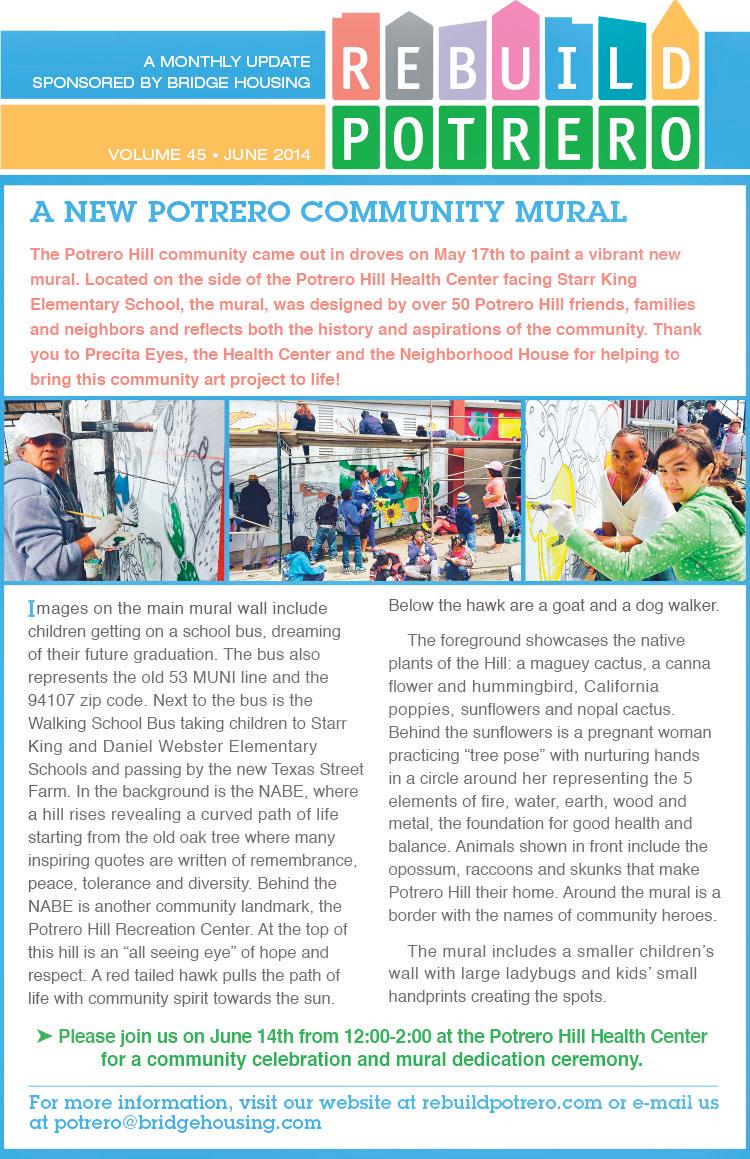

Being a good doctor is about more than practicing good medicine. It’s about preventing illness. Being proactive. Taking time to really listen. And giving our members the personalized care they deserve.
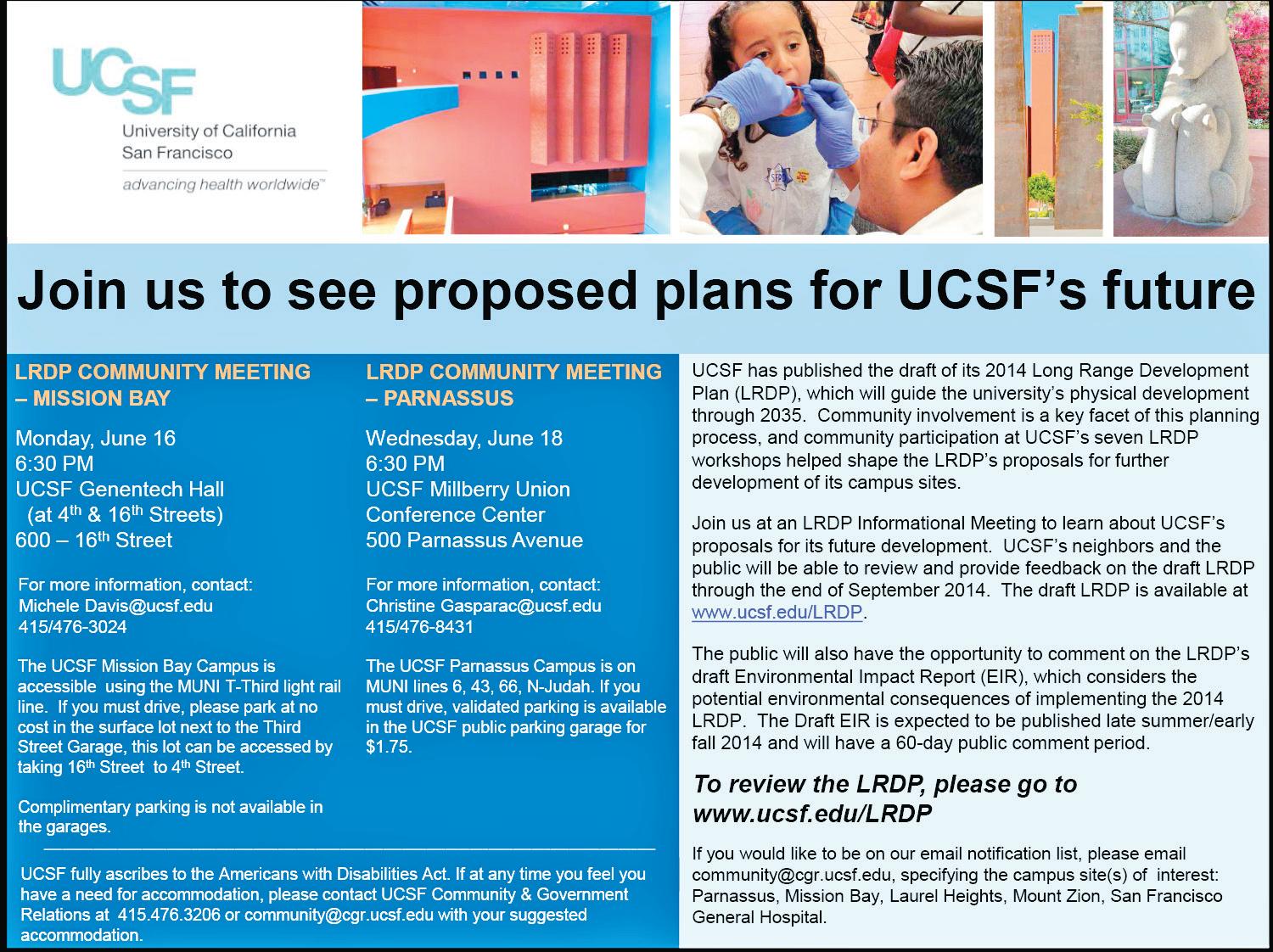


This is the fourth in a series of View interviews with principals of public schools located in the neighborhood. A different school will be featured monthly throughout the summer.
Caroline Gifford is the principal of KIPP San Francisco College Preparatory, which opened in Potrero Hill for the 2013 school year with a ninth grade class of 120 students. She started her education career as a teacher at a charter school in Washington, DC before becoming a history teacher and later an administrator at KIPP San Jose Collegiate.
View: What should the community know about the school?
Gifford: KIPP San Francisco College Prep, we are what we sound like, we’re a public charter school dedicated to getting all students to and through college. We serve students predominantly from low-income communities.
KIPP page 13
While the Golden State Warriors’ pivot to Mission Bay has captured the lion’s share of sports-related development attention, the San Francisco Giants are similarly in the process of developing another nearby area, at the Port’s Seawall Lot 337 and Pier 48. Under the Giants’ proposal, land that currently serves mostly as a parking lot would be transformed into a park, rental housing, commercial space for shops and eateries, and a new Anchor Steam Brewing Company pub.
According to project proponents, the development will provide Mission Bay residents with needed services and retail, and add housing, including affordable units. Opponents are concerned about traffic, transit capacity in the area, and the role the Giants are playing in developing the property. An additional complication is that passage of Proposition B, the Waterfront Height Limit Right to Vote Act, which is on this month’s election ballot, would require any future development on Port land that exceeds existing height limits to be approved by the voters. The Giants’ current proposal includes a 380-foot tower, at least six times higher than what’s allowed under zoning rules. Last month, the Giants said they intended to downsize their development plans.

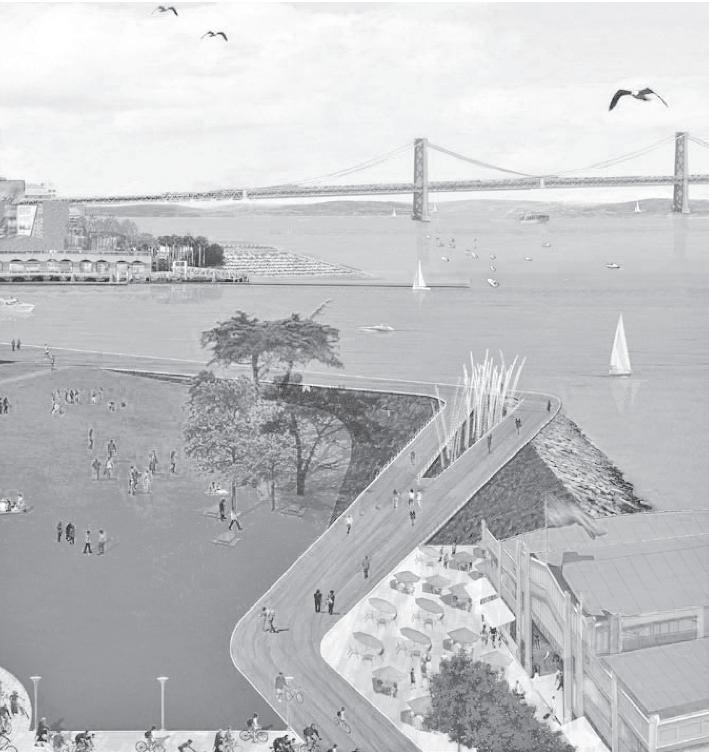
The public planning process for the project began in the early 2000s, when the Port called for development proposals that met the City’s vision in terms of building characteristics and community amenities. Current plans call for 600 to 1,500 residential rental units, and 150,000 to 200,000 square feet of commercial space.
“The community has always been an important part of the planning process. We’ve been working with local residents and investors since 2007 on a plan for the site,” said Phil Williamson, Port of San Francisco project manager. “Plans will change, as they tend to over time and with community input. We’ve been continuously refining the project since then, and the main revision we’ve seen in the plan since 2007 was the estimated amount of time necessary for development. Since the economy suffered, the project was stalled, as there was a need to look at what the market was doing.”
According to the Port’s website, optimally the project would launch next year, with staggered design and building occurring through 2021. That timeframe, however, seems unlikely.
“There is still a lot more community outreach to do in order to get the look and feel of this project,” said Williamson. “Based on our research and homework, we know that there is support in the community for projects like this, no matter what the outcome of the June vote. What the final heights are remain to be seen. We remain encouraged by the input we’ve received so far, and our take-away is there is still support for some height at the site.” Building up instead of out would allow for more density and open space; current plans call for eight acres of park space.
While Port staff are enthusiastic about the project, others aren’t as sure. “Among the most complicated parts of the job: the site has none of the infrastructure that you need for
—
intensive residential and commercial development. So the first step – and it won’t be cheap – is to do the water, sewer, electrical, and road work. The price tag: $120 million,” wrote Tim Redmond in his blog, 48 Hills. The project’s cost isn’t Redmond’s only concern. Because it’s funded by private investors, the Giants are financing efforts to make the lot developmentready. “It’s odd that the City is in effect hiring a private developer to do public works, and then paying a premium for the service. Under the terms of the deal, San Francisco will use a combination of sources, including rent credits and bond money – that is, borrowed money – to repay the Giants, not only for the work that’s been done, but for a 20 percent guaranteed profit; on public-works infrastructure to serve a private development.”
Redmond is also concerned about public transportation, stating that Muni is already overloaded with passengers traveling San Francisco’s Southside neighborhoods. Adding an infrastructure of the magnitude of the Seawall project would require that the City upgrade and expand Muni, particularly the T-line, which is already congested during Giants’ game days. Redmond’s concerns are backed by San Francisco’s development history; he points out that there’s yet to be a project of this size that has fully paid the cost of the public transportation it requires.
The Giants are "…revisiting the project, they’re reconsidering the height limits,” former San Francisco mayor Art Agnos said. Agnos said he was confident that the team will come up with something palatable.




DISTRICT 10 from Front Page
affordable housing, jobs, and safety. “We need to create a big social enterprise and employ folks in the community,” said Donaldson.
While Potrero Hill residents also want a supervisor who focuses on affordable housing, the candidates pointed to other interests specific to District 10 neighborhoods, including transportation, parking, height limits on new developments, and open space and parks.
Carl Bryant moved to Thomas Street in 2011. He was shocked to see so many people hanging out on the street, particularly around the Bayview Opera House, without the presence of police or social services. “I didn’t see any people representing the City out on the streets,” Bryant said, adding that because “Bayview-Hunters Point is a volatile area, you’d think that the City would have a greater presence.”
The top supervisorial issues for Bryant are housing and jobs. If the community had affordable places to live and employment opportunities, he said it’d take care of the crime and safety issues. “They all have to do with the economy.” Bryant thought of running for supervisor before he met Tran. Her agenda aligned with his, and he became an avid supporter.
High housing costs affect Hill and Dogpatch residents too. “The issues in

District 10 are the same issues affecting the City as a whole: a growing population and the affordability of housing,” said Potrero Boosters president J.R. Eppler. “Our concern is that we have not seen the city services needed to support the population growth in our district, nor have we seen concrete plans to provide these services.” The Boosters doesn’t endorse candidates, but Eppler said that the candidate who addresses those concerns is the person to vote for.
For Susan Eslick, the District 10 race hasn’t registered too high on her radar, but “I’m watching Tony Kelly for sure.” Eslick has focused on rallying support for Proposition B, which requires voter approval for developments
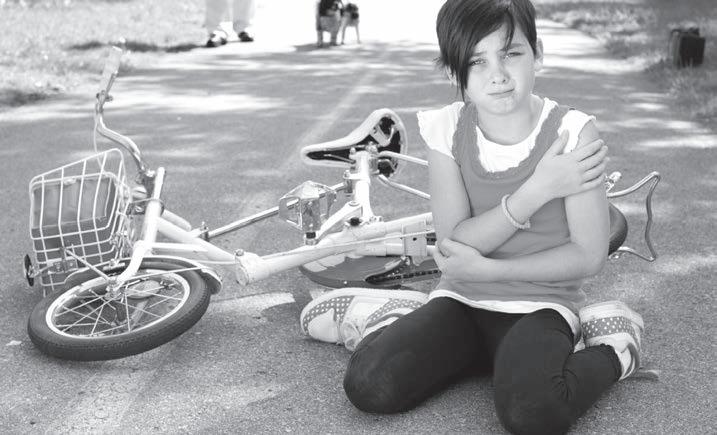

on waterfront land owned by the Port Authority, and is on this month’s ballot.
Right now, Kelly is probably Cohen’s biggest threat. He’s been endorsed by Supervisor John Avalos and SF Rising, an organization of low-income, working class minorities that advocate for community-based agendas. SF Rising also endorsed candidates Ed Donaldson and DeBray Carpenter.
“I’m a Tony Kelly fan,” said Dick Millet, who has lived on the Hill for 45 years. Millet voted for Kelly in 2010. He believes Kelly would represent the people of District 10, rather than corporate interests. “Tony is not connected to the Chamber of Commerce or the supposedly powers that be.” Millet
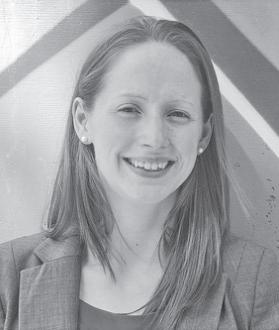
has long been involved with community issues. He’s the Booster’s vice president, and a member of the Mission Bay Community Advisory Committee, and of the University of California, San Francisco Community Advisory Group. Millet said he thinks Cohen is using the district as a steppingstone for her career.
Next month the Potrero Hill Democratic Club will host a District 10 candidate debate. Cohen and Kelly have confirmed their attendance, said club president Joni Eisen, though all candidates will be invited to participate. The club hasn’t endorsed a candidate yet; its 75 members will vote sometime this summer. An endorsement from the club requires the candidate secure 60 percent of the vote. In 2010 the club endorsed Kelly.
Transportation is a huge concern for many of Potrero and Dogpatch residents.
“We feel shafted the most with transportation,” said Eisen, adding that she tried to use the Muni trip planner online to get from the Hill to North Beach, but the route included taking Caltrans. “It’s insane how bad it is.”
Yet Eisen wondered how much pull a supervisor has on the San Francisco Municipal Transportation Agency. Still, she wants a supervisor willing to fight for the community. “The supervisor should draw attention, pass resolutions, grandstand. Do something,” Eisen said.
Gifford: We’re an open enrollment public school; we’re just a public charter school. We have an application process; it’s just a form. It doesn’t require any essays or recommendations or anything. The parent and the student fill out the form together, and then we have a lottery. This year, we did our lottery last December for next year. And it’s open enrollment; it’s whoever gets picked in the lottery. We take about 140 students in a class. This year we had over 200 students in the lottery. We have a wait list of 80 students right now. We take students off the wait list as we can. This will change year to year as we grow and become more well known in the City. Around two-thirds of our current ninth graders came from the two KIPP middle schools in the City, KIPP San Francisco Bay in the Western Addition and KIPP Bayview in Bayview-Hunters Point.
View: What are some recent or ongoing initiatives?


About 83 percent of our students are on free or reduced-price lunch. Our goal is that all of our students will not only graduate from high school, and not only go to college, but get all the way through college. We’re trying to prepare all of our students with the academic skills, knowledge, and strength of character to succeed in college and in the world beyond. We opened this past August with 120 ninth grade students. We’ll eventually be ninth through twelfth. We’ll add a grade each year. Right now we share a building with International Studies Academy. We’re on the first floor and they’re on the second and third floors. We don’t know if we’ll be able to stay on this campus; like all charter schools in the area we get our facilities every year through the district, and so we reapply every year.
View: How does a student get into a charter school, and more speci cally into KIPP College Prep?
Gifford: A couple of things make us unique. We’re a blended learning school. Blended learning means that we integrate technology into every classroom. All of our students have Chrome books that the school provides for use on campus, and every teacher integrates them to some extent. Some teachers might use them every day, all day; some teachers might use them every few days, but we really believe that technology can help our students learn better because we can individualize learning better that way. It’s also really important in preparing them for college, since once they get there everything they do will be on the computer.
Another interesting component is we have a partnership with The Boys
buildings. Neighbors wanted to know how high the new structures would be compared to their homes. The errors were so significant that the Planning Department required the developer to hold a second pre-application meeting.
“…the Department will require the sponsor to conduct another preapplication meeting,” Vu wrote in an April email to Williams. In an interview with the View Vu confirmed that Raintree Partners had to hold a second pre-application meeting, a detail Jason Check of Raintree Partners disputed. According to Check, it’s not “technically” a pre-application meeting.
Check is also not worried about the trees. “I don't have a concern that it [the tree removal] will have an adverse impact should it [the development] move forward,” Check said. Raintree Partners cites safety reasons, among others, for the trees' removal.
According to neighborhood activists, the two trees stand as a green haven in a mostly industrial area. Those opposed to the trees’ removal lost an appeal before the San Francisco Board of Appeals. On June 5 the Planning Commission will vote whether to approve the developer's request for a large project authorization. If the development is approved, chain saws could start buzzing shortly thereafter.
The trees and height inaccuracies are only two of those opposed to the development’s gripes, which include issues related to light, air, massing, height, shadows, design, and property values. After last month's second preapplication meeting, residents left
discouraged because they don't think Raintree Partners is listening to them. However, Raintree has redesigned the project to allow more light and air for adjacent neighbors, in response to a Planning Department suggestion.
Neighbors argue that the design, massing, and height don't fit the location, which is across from The Ramp restaurant. Raintree Partners is merging three lots to build two structures, an activity discouraged by the Eastern Neighborhoods Plan. The two adjacent owner-occupied buildings to the north of 2051 Third Street have 12 units and 15 units. The proposed project would be 68 feet high, the height limit for the lot.
“It was designed in a vacuum,” said Lori Maak-Ingram, an architect who advocated for residents at last month's meeting. “It wasn't designed to be neighborly,” she told Check. “You can choose to go lower.” But Jonathan Ennis, BDE Architecture, the project's designer, was unfazed by MaakIngram's comments. “The environment has changed to support that,” he said of the building height. And though the height limit is 68 feet, stairwells and elevator penthouses could raise parts of the structure to as high as 83 feet under the Planning Code.
Nearby residents are also dismayed that the new building may cast shadows on the proposed Crane Cove Park, which, if built, will be directly across from the project site. According to the Port of San Francisco’s website, “Crane Cove is set to be one of the most celebrated new parks in the City.” “The proposed park would be under the jurisdiction of the Port of San Francisco, and is therefore not subject to Section
295 of the Planning Code,” wrote Vu in the April email. “Additionally, the proposed Crane Cove Park project has not yet been submitted for either an entitlement application or environmental review and is therefore, for purposes of CEQA, not considered a reasonably foreseeable project which should have been analyzed in the environmental review for 2051 Third Street.”
Section 295 of the Planning Code regulates buildings more than 40 feet high and applies only to San Francisco Recreation and Park Department land. The proposed park is on Port of San Francisco property. David Beaupre, the Port’s senior waterfront planner, wondered what the fuss is about. The Port had planned to construct a building at the park, and he didn't think the shadows cast by that building would have been significant.
“Planning Code Section 147 requires reduction of substantial shadow impacts on public plazas and other publically accessible spaces other than those protected under Planning Code Section 295,” states a February 27, 2014 draft Planning Commission motion. This would seem to include Crane Cove Park. Section 147 applies to buildings more than 50 feet in height in C-3, South of Market Mixed Use and Eastern Neighborhoods Mixed Use Districts. According to the Planning Department, the Third Street property is in an Urban Mixed Use district.
“I have observed the shadow path of the recently built development by Build Inc. located between 18th and 19th,” wrote Topher Delaney, of Delaney + Chin, which has offices at 600 Illinois Street, just north of 2051 Third
INVISIBLE from page 5
disappears on Thursdays to attend a different facility so he can dance and enjoy accordion music. A retired Lt. Col. from the U.S. Army, he’s a native of San Francisco, as were his parents, who were in the shipping industry. Nowadays, Al has a pickup truck full of firewood; ready for sale or to give away to his friends. Then, out comes his pen and puzzle book, and he’s thinking about his days as a dance-host for a cruise line! Now that’s a career!
Saved for last are the dear thoughtful hardworking Nabe “crew.” These are Jean, Ed, and Delores – and volunteers – who greet us daily with smiles and treats. There’s no written list of duties to perform, but everything is done with humor and kindness. Where else would “the boss” bring a huge, warm peach cobbler for lunch; served with huge gobs of ice cream!
As for me, I’m just an old broad who likes people. I’ve been Mom, teacher, shop owner, involved in my community in Western Pennsylvania, and even Miss January at age 80 in a best-selling calendar. Now I’m Gramma to Caroline, living in a Kansas Street earthquake cottage, with excellent health, and a well-working brain.
Street. “The shadow plane clearly covers the entire proposed lawn adjacent to the slipway. This observation was at 6 p.m. on May 15. Crane Cove is slated…for use by a community which has very few green areas. To shade this park countermands the purpose of the park's use.”


Bayview, Visitacion Valley
ABC Auto Parts
O’Reilly Auto Parts (San Bruno)
O’Reilly Auto Parts (Bayshore)
Davidson Garage
Civic Center, Tenderloin
San Francisco Honda
Golden Gate Jeep
Excelsior, Ingleside
76 Auto Care
Mission Auto Service
Fisherman’s Wharf, North Beach
Hyde Street Harbor Marina
Haight, Panhandle
Quality Tune-up (Fell)
Laurel /Pacific Heights
Firestone (Geary)
Pacific Heights Chevron
Marina, Cow Hollow
SF Honda’s Marina Service Center
San Francisco Marina Yacht Harbor
Mission, Potrero, Bernal Heights Autozone
Oil Changer
O’Reilly Auto Parts (3146 Mission)
SF Auto Repair Center
Richmond
Jiffy Lube (Geary)
O’Reilly Auto Parts (Geary)
Russian Hill, Nob Hill
Jiffy Lube (Van Ness)
Mark Morris Tires
South of Market (SOMA)
Firestone (Mission)
Oil Can Henry’s
BMW Motorcycles of SF
Sunset
O’Reilly Auto Parts (Taraval)
Pennzoil 10 Minute Lube
Precise Auto Chevron
SF Honda’s 9th Ave. Service Center
Sunset 76





For the proposed development at 1601 Mariposa
(Current site of MacKenzie Auto Parts)
Wednesday, June 4th, 7 p.m.
International Studies Academy, 655 De Haro Street
THE PLANNING DEPARTMENT NEEDS YOUR INPUT :
Speak out about which environmental impacts should be examined. Provide your comments on the scope and content of the environmental impact analysis.
For more information, visit growpotreroresponsibly.com
If you are unable to attend in-person, June 13th is the deadline for submission of written comments.


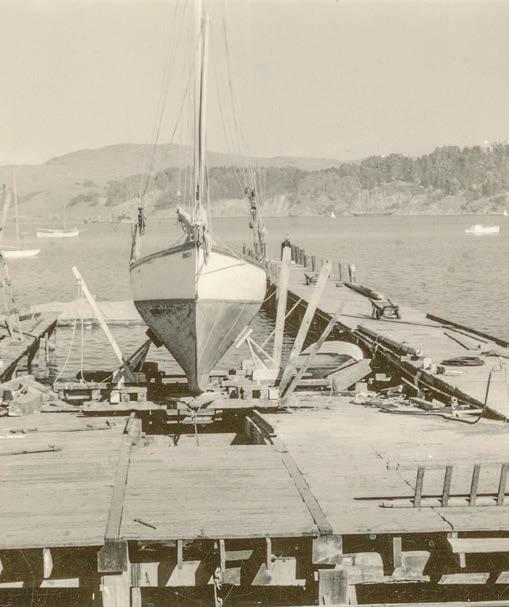


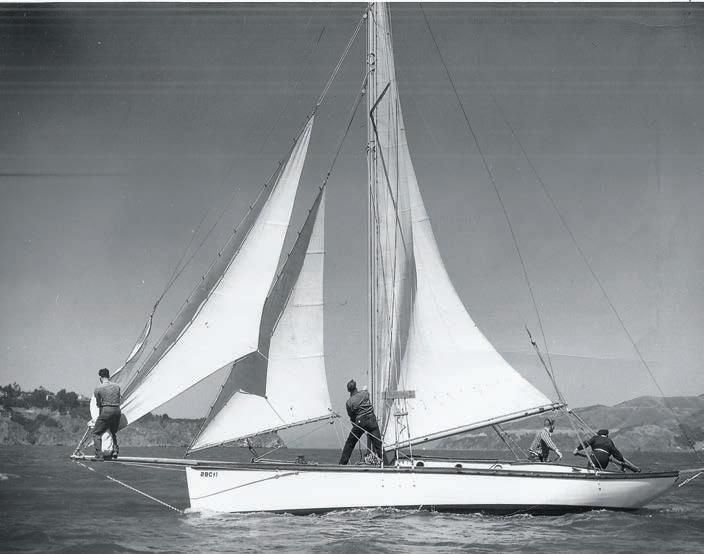

In a complicated world, Altschool’s philosophy is simple. “We wanted to create a school that embodies exactly what we would want if we were students,” said Anna Cueni, the school’s vice president of operations.
Dogpatch-based AltSchool is a private micro-school network founded by technology entrepreneur and Google executive Max Ventilla in 2013. The kindergarten through eighth grade network emphasizes personalized learning and community-building. The school’s first location, on Third Street, has 20 students in one classroom. Future sites will have 20 to 80 students in one to four classrooms, with a low studentto-teacher ratio. Students are taught in cross-age clusters: kindergarten and first, second through fifth, and sixth through eighth.
Altschool is creating a series of neighborhood micro-schools that emphasize personalization. “We create a personalized learning experience based on each child’s skill levels, interests, goals, and learning styles,” said Cueni.
As part of the admissions process students are interviewed, and a learner profile is created to reflect each child’s needs and learning styles, which forms the basis for a personalized learning plan. Dubbed a “playlist,” objectives and milestones for each student are identified in mathematics, language arts, science, technology and engi -
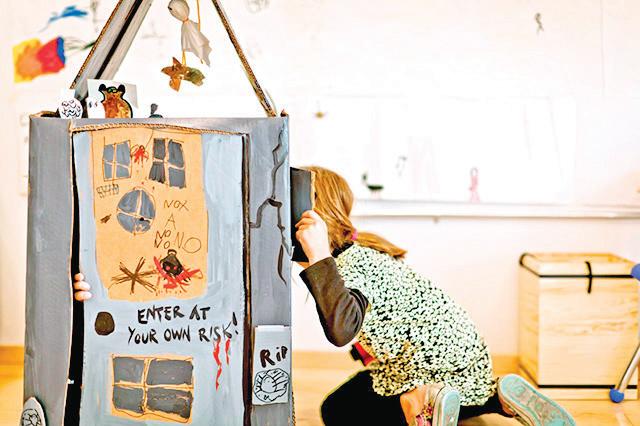
neering, arts, foreign language, social and emotional learning, and fitness and physical education. The playlist is technology-based – it requires a computer or tablet screen to access –grounded in the real world, and often involves a hands-on project.
For instance, a student drawn to comic books may craft a project that creates a comic book hero in colonial America. Or a child interested in food might have a math problem that uses a restaurant as an example. The PLP is developed collaboratively with Altschool’s teachers, staff – who tend to have a technological background
– family, and even fellow students. Learning experiences built into the curriculum are continually altered as students and teachers gain experience with them in the classroom. AltSchool students mix across traditional grade levels. Kindergartners mingle with fifth graders and grades in between. While on paper a student may be a third grader, they could be operating at a fifth grade math level, but have the organizational skills of a second grader. “Education is crafted by a specific child to meet his or her needs specifically,” Cueni said. In Dogpatch the students share the same

2,000-square-feet space, though they engage in different activities.
A typical day at AltSchool starts between 8:30 and 9:30 a.m. The wide drop-off window enables families to arrive when it’s convenient for them. Students start their day by picking up their playlist and working on the assigned activities for the week. At 9:30 a.m. the whole school gets together and prepares for a field trip or engages in a general discussion about a topic. Afterwards, the students go back to their playlist, and then may break into small groups. One student may
ALTSCHOOL page 19

ALTSCHOOL from page 18
be making a movie, another practicing spelling words, while a third works on math concepts with a teacher.
After lunch the students walk to My Gym Fitness Center for exercise, both a nod to the school’s small “campus” and part of AltSchool’s commitment to using community resources. Then, the students might have special class programming, such as learning Spanish or playing music. Or they might go on a field trip in Dogpatch, the Mission, Mission Bay, or Potrero Hill.
According to Cueni, students go on field trips twice weekly, to provide them with real-world experience. For instance, the students met a glassblower recently. And they’ve been to the Mission Science Workshop – a hands-on, nonprofit space that educates 3,000 children year-round from 20 San Francisco schools where science is sparse or nonexistent – a couple of times. “We encourage parents to come in and kids go out into the community and meet people,” she said.
“I LOVE SCHOOL SO MUCH I NEVER WANT TO LEAVE. IT’S LIKE BEING HOME, EXCEPT YOU LEARN. ”
— Five-year-old student
“I cannot overstate how thrilled we are; all three of us,” said Diamond Heights resident and AltSchool mom Renee Zavislak. “Ruby [my daughter] has come home every day this week bursting with excitement: ‘Mommy, today we read a book about Helen Keller, and did you know that she couldn't talk OR see OR hear, but then her teacher, Annie, taught her to read?' 'Mommy, I LOVE the Mission Science Center; and can I get a pet snake?’ ‘Mommy, today I made a video with other kids about The Three Bears and then we got to watch it on THE BIG SCREEN!' ‘Mommy, today we read a book called Many Moons and then we drew pictures of what we thought the characters look like.’”
The children can be picked up at
around 3 p.m., or remain in aftercare until 6 p.m. “It’s very popular,” Cueni said, of the aftercare program. “At first just a few kids stayed for aftercare and now most stay at least one day a week depending on what activity they might like to do.” The aftercare program mostly serves as an optional extension of the school day, with the students working from their playlist, though the focus is on art and nature programs.
AltSchool’s tuition is $18,400, increasing to $19,100 this fall. Tuition assistance is offered based on financial need. The school practices blind admissions, because it wants a mix of students, according to Cueni. “We want a wide range of children, not to pride ourselves on how many students we reject and to have a low acceptance rate,” she said. The school wants to create a balance in terms of its students’ qualities, what types of learners are in the classroom, how enthusiastic or focused they are, how well they’ll be able to learn from each other, what the social dynamics will be, and how manageable a classroom will be for a teacher.
“I love school so much,” said one five-year-old student. “I never want to leave. It’s just like being home, except you learn.”
Next year, AltSchool will add two middle schools, one South-of-Market, the other in the Marina that will also feature an elementary school, as well as another elementary campus in Hayes Valley. The company is scouting locations in Palo Alto, Mountain View, and the East Bay, and plans to expand throughout the Bay Area and other U.S. locations, including New York City, in the next few years.
AltSchool is privately funded by venture and philanthropic sources. It raised a $33 million Series A round of financing last March from Founders Fund, Andreessen Horowitz, First Round Capital, Harrison Metal, John Doerr, Jonathan Sackler, Learn Capital, Omidyar Network, and other investors. Following that funding round, AltSchool initiated the process of becoming a certified B Corporation.




each annually.
The caregiver parking permit process was created after parents’ groups advocated for a way to allow out-of-town nannies to park near the homes where they provide childcare. The system was implemented in 2011. Last spring there were five pages of “approved” blocks, meaning a family had already gone through the process of getting neighborhood approval, which will continue in perpetuity. In Potrero Hill only eight blocks have been approved for the special permit.
About a year and a half ago De Haro Street resident Mary Zimmerle secured a permit for her infant son’s babysitter so she could return to work as a psychologist. According to Zimmerle, the application process was “painless.” She took advantage of signature-gathering to meet new people on her block. Though she’s lived on De Haro Street for roughly three years, and been a Potrero Hill resident for nearly a decade, she created at least one new friendship with a neighbor she didn’t previously know.
Zimmerle said that her De Haro Street block, located near Starr King Open Space, has enough parking that none of her neighbors cared about giving up one spot during the week. “I bet if I tried in other neighborhoods, I would have gotten a lot of pushback,” she said. As she canvassed her block she realized that many people didn’t know there was an option for nannies to get a parking permit. Yet without it her nanny had to move her car every couple hours while caring for a baby and another child from a family with whom Zimmerle shares care. “It had become annoying,” she said.
Before Zimmerle trooped around the neighborhood to get her petition signed, she had to “psyche myself up and see this as a way to meet neighbors.” She tasked herself with signature duty because she didn’t want to put the burden on her sitter, for whom English is a second language. Collecting the necessary signatures took less than a half-hour. It was the easiest part of the application packet, which she then had to submit in person at SFMTA’s office.
For 29-year-old Autumn Brown Garibay gathering the necessary parking permit signatures was part of the job while working for a Lower Haight family in 2012. A Mission District resident, Garibay said that canvassing was easy. She set aside 30 minutes on two separate evenings to coax neighbors to sign the petition. “I went around and said I was working in the neighborhood. Most people were cool with it.” She only encountered one neighbor who was irritated about being asked, and used it as opportunity to complain about the community changing.
Garibay admitted that she’s comfortable going door-to-door, and knows
that the task would have proven challenging or unappealing for other nannies. “A lot of people in that profession aren’t necessarily proficient in English,” she said. “It could be unfair.” She said the biggest problem was SFMTA enforcement being unfamiliar with what was then a new program. She got several tickets as the kinks in the system were worked out. “They weren’t informed,” she said.
Garibay called the nanny permits “family-friendly.” It was nearly impossible to move her car every couple of hours while caring for a two-year-old.
“I wouldn’t have been able to do my job if I didn’t have it,” she said. Unlike other caregivers, who rely on public transportation, taxis, or rideshare services to shuttle their charges, the permit provided Garibay with the flexibility of her own vehicle. “It’s a great way for a more middle-class family to be able to have consistent high-value care for their child while also thinking about the caretaker side of things as well,” she said. “There needs to be more awareness and outreach for parents and people with children.”
According to Giada Barbini, office manager at the La Scuola Italian International School in Dogpatch, the permitted parking exemption doesn’t have a wide enough reach. She said teachers and staff at the 20th Street school don’t qualify as child caretakers and aren’t area residents. Parking is a major issue.
As Dogpatch develops, Barbini is optimistic that residential parking permits may eventually be allowed for her teachers. But in the meantime educators are left juggling teaching and watching the clock to avoid a parking ticket. There’s no parking at the school building. A nonprofit, La Scuola can’t afford to provide transportation options for their staff of 36 teachers and other employees, who commute from other San Francisco neighborhoods, the East Bay, and Peninsula.
Barbini said the school encourages its staff to carpool and avoid driving because it’s “hard for them to come here with their cars.” Anyone who believes that there’s plenty of parking in Dogpatch hasn’t visited the neighborhood swath where construction crews take up most of the space, car-sharing services reserve parking spaces, and all-day parking is gobbled up by residents, she said. She credited many of the school’s staff for biking and taking Muni or Caltrans to work. However, for those who rely on driving, “I wish there were a few exceptions made for a school,” Barbini said.
More information about obtaining a child caregiver parking permit: http://www.sfmta.com/services/ permits-citations/parking-permits/ residential-area-permits/rpp-types/ child-caregiver
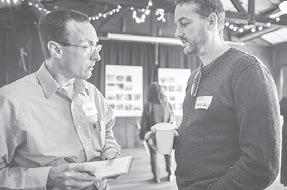

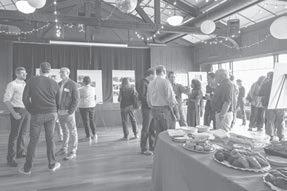
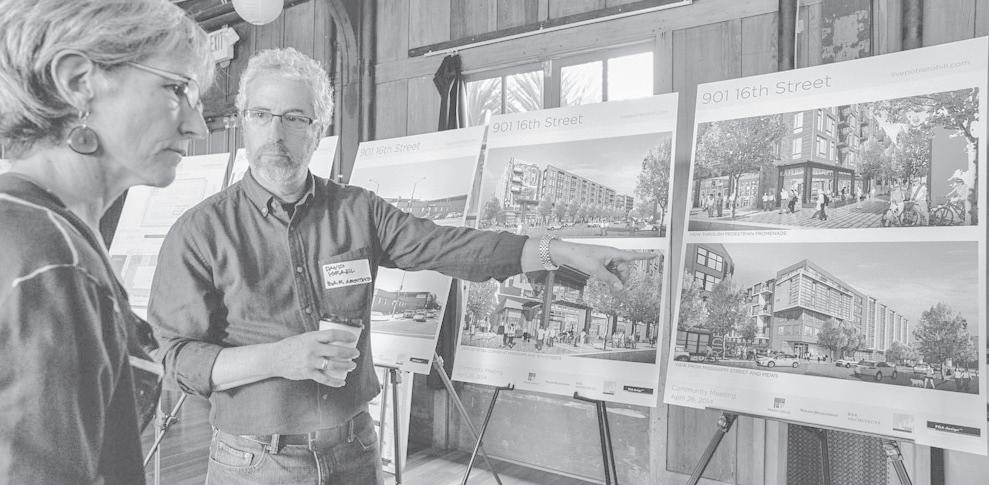 BY KEITH BURBANK
BY KEITH BURBANK
At a recent neighborhood meeting at the Potrero Hill Neighborhood House, members of the Cor-o-Van development team, which includes the Prado Group, Walden Development, Christiani Johnson Architects and BAR Architects, said they heard mostly positive feedback about the project's initial design. According to Dan Safier, Pardo Group president, the design reflects input from multiple Hill residents, though he noted that it’s impossible to please everyone.
Resident feelings about the project appear to be mixed. Some say the existing structures on the site are historic, and want them retained and reused. Others believe the buildings should be torn down.
“Most of the structures on that site are not that pretty,” said Arkansas Street resident Jeff Pratt, adding preserving them isn't warranted.
According to Potrero Boosters vice president Dick Millet, the industrial buildings are meant to be torn down. He thinks some residents are advocating for adaptive re-use to kill the project.
Safier said the existing buildings wall off the community. If the proposed project is built, the neighborhood will start at 16th and Mississippi streets. In prepared statements for the View, Safier discussed the benefits of his proposal, which he claimed would advance housing, transit, bike travel, walking, and “active neighborhoodserving retail uses.”
The proposed design consists of two buildings with addresses at 901 16th Street and 1200 17th Street. On 16th Street, Prado Group wants to build about 259 housing units, roughly 41 of which would be priced below market. The developer is planning about a dozen three-bedroom units at the site, roughly 220 residential parking spaces, and about 261 secure bicycle parking spaces. BAR Architects’ David Israel designed the site for about 17,500 square feet of retail space, which Safier said could be divided into five to 10 shops.
On 17th Street, Prado Group wants to build about 135 housing units, roughly 19 of which will be below

market rate, and about five of which will be three-bedroom units. Christiani Johnson Architects designed the site for about 115 residential parking spaces, two to four retail shops, and roughly 191 secure bike parking spaces.
Safier said his proposal is a “holistic vision” for a complete neighborhood. The housing will be affordable for residents at a variety of income levels. The design includes street furniture, wider sidewalks, a pathway through the site aligned with the future Daggett Park, and about 12,000 square feet of publicly available but privately maintained

green space, with outdoor seating and gathering spaces. And Prado Group will contribute “substantial funds” to the City in the form of community impact fees.
The design was informed by input from community organizations, including the Boosters and the Dogpatch Neighborhood Association. The team has had dozens of meetings with individual residents, business and property owners, as well as other community stakeholders, including members of Save the Hill.
Prado Group highlighted its pro -
posal to restore the site’s historic brick building for retail use rather than as an entry to the development. And the team proposes to “retain the metal clad timber building” located at 17th and Mississippi streets for retail uses.
“We remain committed to listening and gathering community input throughout the entitlement process in order to design a project that maximizes the ideas from the community and respects the unique characteristics of Potrero Hill and the surrounding area,” said Josh Smith, of Walden Development.

I was at the first day of a meditation retreat deep within New Mexico’s mountains. After the dozen participants had assembled on the deck of the log cabin main lodge, we spent several hours getting to know one another, and learning the basics of mindfulness.
As the sun dropped towards the horizon, we were assigned to prepitched tents, which were dispersed throughout the forest surrounding the lodge, none located less than a couple hundred yards from another. After a dinner of salad, rice, and chicken, and some casual conversation, we broke up for the night, and made our way to our tents, flashlights in hand.
I unpacked my gear, placing a book and my flashlight on the wooden box that served as a night stand, and got into my sleeping bag on top of a canvas cot. I was drifting towards sleep, when someone called out my name.
“Steven! Mr. Moss!” a man’s voice urgently whispered. The tent flap flew open, and the retreat center’s night watchman thrust his head in. “Your wife just called. Your daughter is sick; she’s at the hospital.”
“What? What?” I said.
“Your wife,” the watchman said more slowly. “She called the main office and said she took your daughter to the emergency room. She said she’s okay, but she’s in the hospital.”
I immediately grabbed my things and started stuffing them into my duffle bag. “I need to get to the airport,” I said. The man nodded.
Within minutes I was outside the tent, walking with the watchman, who was in his early 20s, towards the lodge,
where the cars were parked, while simultaneously trying to call Debbie on my cellphone.
“We don’t get cell service up here,” the young man reminded me. “You’ll have to wait until we get down the highway a few miles.”
We walked in silence, the forest needles crunching beneath our feet. It was deep black, with an occasional star peeking through the overcast night. The watchman’s large flashlight illuminated the trail and the trees crowded around it.
“You sure you want to leave?” he asked. “Your wife said your daughter was okay.” He paused. “I mean, I’m happy to drive you.”
“Thanks,” I replied. “I need to go.”
My heart was pounding from having been woken up by such distressing news, so far away from my wife and 18-month-old daughter. We got into the retreat center’s truck, and started down the road. After several miles I tried my cell again; still no reception. I looked at my driver, and noticed the tattoos on his neck. Neither of us said anything, as I repeatedly punched the redial button. Finally, halfway down the mountain, I reached my wife in the emergency room.
“What’s going on,” I asked. “How’s Sara?”
“She’s okay,” said Debbie. “She woke up after I put her to bed and couldn’t breathe. She kept gasping for air. So I drove her to the hospital. She’s
okay now.”
“What happened?”
“The doctors said she has some sort of respiratory virus. They gave her oxygen and some medicine.” Debbie paused. “She’s okay now,” she repeated.
“Okay. I’m on my way to the airport. I’ll catch the next flight home, though it may not be until morning. I’ll get there as soon as I can”
“I don’t think you need to do that,” Debbie said. “When I called I was really worried, and thought you needed to know what was going on. But she’s fine.”
“I’m coming home,” I said.
“Okay,” Debbie sounded relieved. We hung up.
Two months after 9/11, Debbie, Sara, and I traveled to New York to attend a wedding. Though the ceremony was being held upstate from Manhattan, we were intensely curious about what had happened at the World Trade Towers, and wanted to see the destruction. Debbie questioned whether it was a good idea to bring a four-month-old near the site. But the federal government insisted that the air was safe.
Still in mid-hubris about being a new parent, and anxious to view the aftermath of the shocking events we’d seen on television, I didn’t stop to consider that, no matter what the U.S. Environmental Protection Agency publicly stated, my daughter’s new lungs would be especially sensitive to airborne


particles, particularly the toxic kind that had to be floating around the site as a result of clean-up activities.
We checked into our hotel, and took a taxicab to as close to where the World Trade Towers once stood as we could. We slowly strollered Sara around the massive craters, peeking through what was left of the towers, gapping at the astonishing destruction. Occasionally a passerby would glance at our baby and give us a hard look, but, swept away by disaster-sized curiosity, I hardly noticed.
A little more than a year after our New York visit I got the call that woke me from my meditation tent, and brought me home to my family. For the next year after, that Sara struggled with a respiratory problem, the origin and nature of which our doctors couldn’t define. Debbie or I would regularly have to strap a mask over Sara’s mouth and nose and dose her with vaporized medicine. We were deeply rattled, concerned about our daughter’s health and worried that, without a proper diagnosis, we’d never be able to solve her problem. And in the wake of my late-night New Mexico experience I’d tense every time Debbie called, afraid that she was going to report bad news about Sara.
I don’t know if our visit to the 9/11 site caused Sara’s respiratory problems. But it was stupid for us to bring our baby daughter anywhere near what by all accounts was a smoldering, toxic crater. And there’s no lost irony that I was at a meditation retreat, about to go to sleep, when I received a wake-up call. THE


This month I enjoyed two films that explore the price some people pay to follow their moral compass and do “the right thing.” The first movie, For No Good Reason , is a hip, visually striking profile of the life and work of artist Ralph Steadman. The other, Locke, is the fictional story of one night in the life of a calm, controlled, highlycompetent man whose personal and professional life dramatically unwinds over the course of ninety minutes.
I recommend both films. For No Good Reason should be seen on a big screen, where Steadman’s work can be fully appreciated. Locke is a solid thriller and character study that should work fine in your home theater, or on an airplane.
British-born Ralph Steadman is best known for his illustration of a series of articles and books written by gonzo journalist Hunter S. Thompson in the 1970s and 1980s. Steadman’s unique drawings are frequently vibrant and unsettling, complimenting Thompson’s lurid, stream-of-consciousness rantings. Like Thompson’s writing, they appear hurried and dashed off, but are beautiful in their structure and detail. The film captures Steadman’s meticulous work process as he creates splattered and twisted images laden with political expression.
On camera, the still-working Steadman is revealed as a thoughtful, quiet 77-year-old who professes a lifelong desire to use art to make a difference in the world. The acclaim he enjoyed working with Thompson gave him a platform for reaching more people, but didn’t change his art. He eschewed the mainstream opportunities that could have increased his wealth and fame, choosing instead to remain an activist. Over the next three decades he created vicious, dark send-ups of establishment targets: the self-possessed wealthy, the corrupt church, our murderous military-industrial complex, craven politicians, and much else.
For No Good Reason features Johnny Depp – who played Hunter S. Thompson in the film Fear and Loathing in Las Vegas – interviewing Steadman accompanied by beautiful, sometimes animated, displays of Steadman’s amazing work. Though some stylized re-enactments of Steadman’s
adventures with Thompson miss the mark, video footage of the two of them in Las Vegas, at the Kentucky Derby, and covering political conventions, and prize fights are fascinating. The film is directed by cinematographer Charlie Paul.
Remember that scene in the thriller you saw a few years ago where the hero is driving at night, and tension climbs as he talks through some threatening problem on the phone while negotiating traffic? Locke, a new film by Steven Knight (Redemption), multiplies that scene by 100 and builds an entire movie around it. Tom Hardy (Inception, The Dark Knight Rises) plays dedicated family man Ivan Locke who drives into the night following a long day at the construction site where he’s to oversee the critical pouring of the concrete foundation the next morning. Viewers spend the rest of the night with Locke in his car as he jeopardizes his career, his family, and the foundation of “his” skyscraper building by attending the unexpected birth of a child he fathered with a woman he hardly knows.
As he drives, Locke fields dozens of calls from the mother in labor, his wife, his children, his boss – listed as Bastard on his caller ID – the police, and perhaps most gripping, the insecure, inexperienced assistant thrust into Locke’s role orchestrating the multimillion dollar concrete work only hours away. The conversations reveal that Locke has been the dependable, competent, rock of stability for the emotional, often ineffectual people in his life and work. One crisis after another challenge Locke’s composure and his moral certainty, much like his decision to abandon the concrete pour threatens the foundation of his building.
A single-character film that takes place almost entirely inside a car sounds like a long slog for any viewer, but the way the intricate, metaphorladen plot unwinds and the exceptional acting by Hardy make the running time fly by. Kudos to music director Nick Angel, whose collection of exceptional cinematic musical work continues to grow.
Both films will be available on DVD this summer and may screen at San Francisco’s awesome Castro Theatre.
The Internet’s Own Boy: The Story of Aaron Swartz , in its West Coast premiere at the 13th annual SF Documentary Film Festival, is arguably the most important movie of the decade on the government’s draconian approach to cyber crime and its unspeakably tragic results.
Blending home movies with video clips and interviews with family, friends, and intimates, documentarian Brian Knappenberger’s Kickstarter-funded superlative film traces the remarkable story of computer prodigy and Internet activist Aaron Swartz.
From a precocious childhood Swartz became an Internet pioneer and social justice activist. After selling Reddit – the popular social media website he co-founded – Swartz found himself living and working in San Francisco, commuting by bicycle to Condé Nast’s South-of-Market headquarters. Disillusioned by corporate life, Swartz dived into grassroots political advocacy, leading the successful charge to stop proposed federal legislation that would

severely curtail freedom of speech on the Internet. He also founded social justice website DemandProgress.
Indicted on multiple federal charges for violating the Computer Fraud and Abuse Act (CFAA), the 26-year-old faced 35 years in prison for allegedly downloading a trove of publicly available academic articles using a network at MIT, where he worked. Swartz killed himself before his case went to trial.
No matter how one feels about the impact of technology, Internet’s Own Boy is a powerful film that’ll cause you to weep while raising disturbing questions about our justice system and its inability to tell the difference between those who commit crimes that actually cause harm and those fighting for civil liberties both online and off. Advocates are trying to change the CFAA with “Aaron’s Law,” proposed legislation currently on hold on Capitol Hill.
Other films in SF DocFest featuring people and places from the Mission, Bernal Heights, Visitacion Valley, Alamo Square, and Nob Hill, are Ahh... San Francisco, The Crossmaker, Pistols to Porn, True Son, Demolition Troll, Jingle Bell Rock, Goodbye Gauley
Mountain: An Eco-Sexual Love Story and Sunnydale Kids
The festival runs June 5 through June 19 in San Francisco and Oakland. Tickets are $12; passes from $55 to $180 and $10 to $15 for related parties and events. For more information: s ndie. com or 552.5580. Internet’s Own Boy opens July 4 in theatres.

Through August 3
Art: Intimate Impressionism at the Legion of Honor
Eugène Boudin and Johan Barthold Jongkind’s plein-air practice inspired Claude Monet, Pierre-Auguste Renoir, Camille Pissarro, and Alfred Sisley. Complementing paintings of the natural world are depictions of artists’ studios and domestic interiors; several captivating self-portraits by Edgar Degas, Henri Fantin-Latour, Paul Gauguin, and Édouard Vuillard; Renoir’s 1872 portrait of Monet; and representations of the artists’ families, including Berthe Morisot’s The Artist’s Sister at a Window (1869). The temporary closure of the National Gallery’s East Building for major renovation and expansion has made possible the rare opportunity to see this select group of paintings in San Francisco, the exhibition’s first venue. Tickets: $12 to 24. Legion of Honor, 100 34th Avenue. Information: legionofhonor.famsf.org or 750.3620.
Community: Environmental Scoping Meeting
This meetng will review environment concerns about the proposed 316-unit development at 1601 Mariposa. It’ll be an open forum where all can share thoughts about this project, and the impact it could have on the neighborhood. Held by the San Francisco Planning Department. 7 p.m. Free. International Studies Academy, 655 De Haro Street. Information: growpotreroresponsibly.com.
Photography:
Robert Dawson
Over the last eighteen years photographer Robert Dawson has crisscrossed the United States documenting hundreds of public libraries, large and small, old and new, urban and rural, in poor communities and in wealthy ones. This new book, The Public Library Book, presents a wide selection of Dawson’s photographs — from the majestic reading room at the New York Public Library to Allensworth, California’s one-room Tulare County Free Library built by former slaves. There are photographs of literary libraries, storm-damaged libraries, a haunted library, libraries as sanctuaries, libraries as art museums, and libraries as memorials. This beautiful collection documents our vibrant, essential, yet threatened library system as it undergoes profound changes in its identity and purpose, while remaining at the heart of American civic life. Free. 7 to 8:30 p.m. Hattery, 414 Brannan Street. Information: hattery.com
Performance: Entiende Silvio, a Spanish Interpreter at a major hospital, helps people understand each other but can’t understand himself. Caught between his professional obligations to a family with a dying daughter and his single-minded focus to go on a date with a hot doctor, Silvio hides his smoking habit, confides in his own personal

Yoda, and gives families tragic news...none of which keep Silvio from a collision course with his destiny. 8 p.m. Tickets: $15 to 25. Stage Werx Theater, 446 Valencia Street. Information: brownpapertickets.com/event/670926
Health: Introduction to Handcrafted Herbal Medicines
Learn the basic techniques of herbal medicine making, creating several formulas that can boost immunity and promote overall wellness. Learn how to make two types of tinctures, a healing salve and hand-crafted tea blend. All of the combinations created will be appropriate for the summer season to help keep us in optimal health. There’ll be a discussion about how to incorporate medicinal herbs into everyday cooking. You’ll leave the class with samples of our creations, as well as recipes you can re-create at home. Bring a notebook, pen, and a basket to take home all your medicines.
Tickets: $40. 1 p.m. Pollinate Farm and Garden, 2727 Fruitvale Avenue, Oakland. Information: brownpapertickets.com/event/679631
Art: Bead by Bead, Contemporary Native Writing
Bead by Bead: Contemporary Native Writing, is a literary salon featuring authors making critical contributions to the fields of poetry, fiction, and creative nonfiction. Join Jewelle Gomez, Kim Shuck, Indira Allegra, Greg Sarris, Qwo-Li Driskill, Nazbah Tom, and Moon Flower as they offer narratives that attest to the brilliant, ongoing vision of Two-Spirit people. These authors labor over their texts bead by bead, writing stories that can be sewn together to create complex legacies of love and survival for the future to inherit. This is an scent-free event. Tickets: $12 to 20. African American Arts and Culture Complex, 762 Fulton Street. Information: brownpapertickets.com/event/671024
Aubrey Lowe
Join the fifth event in the series, featuring Robert Aiki Aubrey Lowe, an artist and multi-instrumentalist who works with voice to create spontaneous and ecstatic musical compositions. Under the moniker Lichens, Lowe uses effects boxes to loop guitars, percussion, and vocals into a reverberating drone. In 2005, Lichens released The Psychic Nature of Being, followed in 2007 by the album OMNS. His most recent performances and recordings have combined his voice with modular synthesizer patch compositions. Lowe believes that the sensitivity of analogue modular systems echoes the organic nature of vocal expression, and that the two can be used together to induce a trancelike state and promote deeper listening. Tickets: $10 to 15. Space is limited for this event. Exploratorium, Pier 15, Kanbar Forum. Information: exploratorium.edu/resonance/ calendar/robert-aiki-aubrey-lowe.
Dogs: Introduction to Feeding Fresh Foods
This class offers a basic overview of the many ways to feed a natural, whole-foods diet to dogs. The class will cover common myths and concerns, including bacteria, nutritional balance, parasites, digestibility, safety, expense and difficulty/convenience. Learn how to feed dogs with common health concerns (allergies, dental disease/missing teeth, sensitive digestion/digestive disorders), toy breeds, giant breeds, and specific breed concerns; feeding puppies and older dogs. For vegetarians, learn how to feed with fresh foods diet when you don’t normally handle meat. Free. 7 p.m. SFRAW Warehouse, 250 Napolean Street, Unit G. Information: straw.com
Community: UCSF Hospital Long-Range Development Plans
Join us to learn about UCSF’s proposals for its future development. UCSF’s neighbors and the public will be able to review and provide feedback on draft plans through the end of September 2014. The public will also have the opportunity to comment on the plan’s draft Environmental Impact Report (EIR). The Draft EIR is expected to be published late summer or early fall 2014, and will have a 60-day public comment period. The draft plan is available at www. ucsf.edu/LRDP. 6:30 p.m. Free. USCF Genentech Hall, 600-16th Street. Information:micheledavis@ ucsf.edu or 476.3024
Food: Burrata CheeseMaking by Hand
The most exciting cheese on the cheese board needs little explanation. Burrata is fresh mozzarella filled with luscious cream and more cheese. In this action-packed evening class, you’ll learn the basics of cheesemaking, including which milk to use, where to find cultures, and options for rennet. You’ll leave with a deeper understanding of the science behind the process. 6 p.m. Tickets: $65. 18 Reasons, 3674 - 18th Street. Information: sfmilkmaid.com.
Community: Summer Solstice Celebration
Join in the celebration of the longest day of the year. Participate in an age-old tradition of celebrating midsummer on the solstice, marking the astronomical beginning of summer. Savor two complimentary glasses of California wine and nibble on local cheeses while strolling through our 100-year-old Redwood grove. Explore the lush trails of woodland sorrel, wild ginger, and sword ferns. Tickets: $20 to 30. 6 p.m. San Francisco Botanical Gardens, 1199 Ninth Avenue. Information: sfbg.org
Kids: MakeArt: Reimagined Costume Jewelry Accessories
The worshop begins with a tour of Jennifer Crupi: A Display of Gestures, an exhibition of 15 wearable artworks in metal exploring body language and communication. Then spend the afternoon deconstructing costume jewelry from our treasure trove. Design, layer, and fasten the jewelry together to create one-ofa-kind accessories. Snack provided. For children ages eight to 12. Tickets: $10. 1:30 to 3:30 p.m. Museum of Craft and Design, 2569 Third Street. Information: sfmcd.org.
Wednesday July 2
Politics: District 10 Supervisor Candidate Debate
Looking ahead to the November 4th election, the Potrero Hill Democratic Club presents a debate featuring incumbent Supervisor Malia Cohen and challenger Tony Kelly; other participants will be announced as they confirm. Moderator will be tpolitics reporter Marisa Lagos, whose focus is the Board of Supervisors. 7:30 p.m. Free and open to the public. Potrero Hill Neighborhood House, 953 De Haro Street @ Southern Heights. For information and updates: www. PHDemClub.org or Facebook.
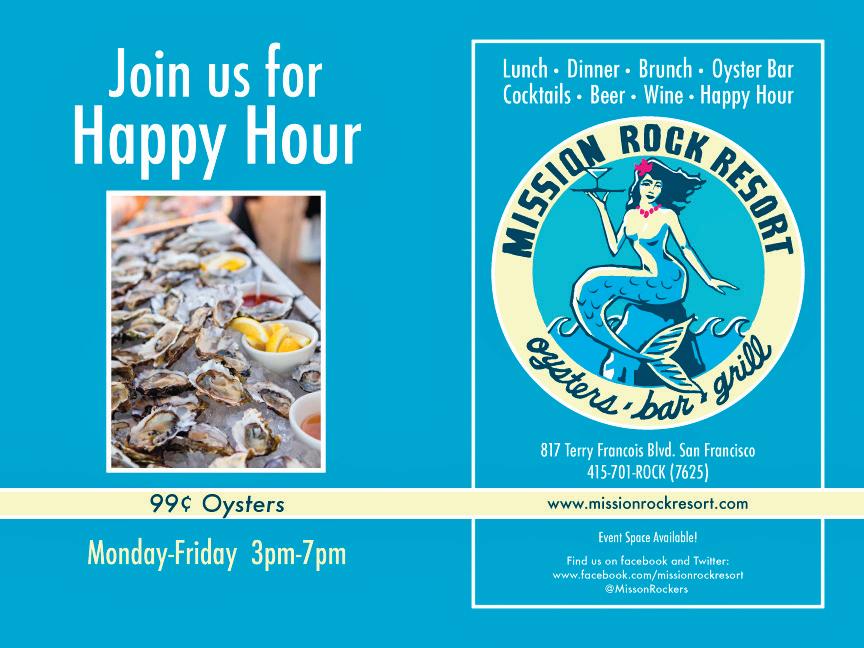




Local filmmakers and subjects once again populate Frameline38, the 38th San Francisco International LGBT Film Festival, which returns to the Bay Area June 19 through 29. The 11-day festival is expected to attract 65,000 film lovers, media artists, and members of the lesbian, gay, bisexual, transgender, queer, and questioning communities — and their allies — to discover the best in queer cinema. The documentaries, features, shorts, and classic films come from more than thirty countries, including Germany, Venezuela, Slovenia, Mexico, Finland, France, and – ironically, given Valdimir Putin’s recent antigay rhetoric — a special spotlight on emerging Russian LGBT cinema.
Opening the festival is The Case Against 8, directed by Ben Cotner and Ryan White. The HBO documentary investigates the first Supreme Court case on marriage equality, following the plaintiffs and the unlikely team of attorneys Ted Olsen and David Boies as



they challenge California’s Proposition 8 ban on same-sex marriage. Shot over five years, and including exclusive behind-the-scenes footage, the film features Berkeley residents Kris Perry and Sandy Stier.
The centerpiece documentary, To Be Takei, celebrates actor and activist George Takei, who experienced a Japanese-American internment camp during World War II, achieved fame for


his role in Star Trek, has millions of Facebook fans, and who, with his husband, Brad, is an advocate for marriage equality. The 90-minute documentary’s director, Jennifer Kroot, lives in the Haight and editor/codirector Bill Weber lives in the Castro. Takei will receive this year’s Frameline Award in honor of his wide-ranging and pioneering contributions to the representation of LGBTQ figures in media.
The South-of-Market neighborhood is well represented by both subjects and filmmakers. Mike Skiff’s Folsom Forever explores the history of the Folsom Street Fair as it turns 30. Also set in SoMa – as well as the Nob Hill Theatre – is Wham, Bam, Mr. Pam , Nicolas Kazamia’s profile of “Mr. Pam,” the former Catholic schoolgirl who became a successful videographer of gay male porn. Prinsesa, directed by Daly City resident Drew Stephens, about a young boy who dreams of becoming a Filipina princess, is centered on
SoMa. Filmmakers residing in SoMa include Aron Kantor, director of the three-minute short, Puppy Love, and Paul King, director of Ladies and Gentleman: Phatima Rude, about the “pioneer of the alternative queer punk drag scene.”
Bay Area resident Zoe Dunning, the first and only openly gay person allowed to remain on active duty in the military prior to the end of the “Don't Ask, Don't Tell” policy, is profiled in Silvia Turchin’s short Veteran Documentary Corps: Zoe Dunning Notorious transsexual chanteuse, Bambi Lake, strolls down pre-AIDS Polk Street, where she once worked as a street hustler and later as a performer in the burgeoning San Francisco 1980s’ punk scene, in Silas Howard’s Sticks & Stones. Actor and comedian Alec Mapa, who was born in San Francisco and attended George Washington High School, is profiled by Andrea James in Alec Mapa: Baby Daddy, which tells how his life has changed since he and his husband adopted a child through foster care.
Noe Valley filmmaker Susan Sullivan’s short First Clue asks women, “What was your first clue you were a lesbian?” Elvira Lind’s documentary Songs for Alexis features local musician Ryan Cassata. Housing First is John Smathers’ investigation into how San Francisco’s housing affordability crises are affecting the LGBTQ community.
Frameline38 screenings will take place in San Francisco at the Castro Theatre, 429 Castro Street, Roxie Theater, 3117 16th Street, and Victoria Theatre, 2961 16th Street, and in Berkeley at Rialto Cinemas Elmwood, 2966 College Avenue. Check the website for schedule and tickets: www.frameline.org/festival.
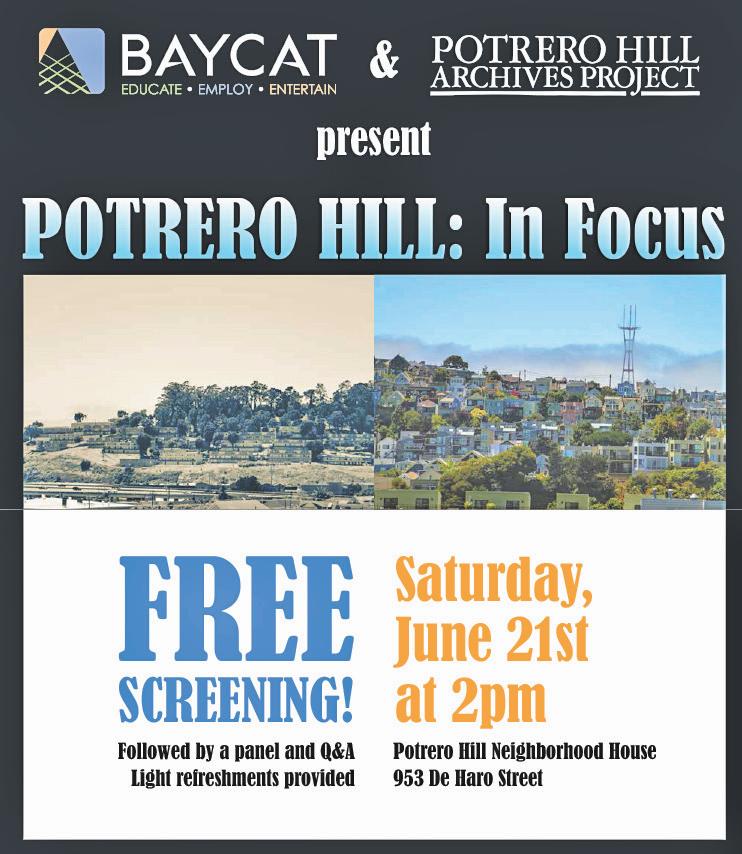
The View asked career expert Mauri Schwartz to answer questions from job seekers.

Q: I’ve come across a number of jobs that sound very interesting, but there always seems to be a skill or experience in the job description that I don’t have. I’m a quick learner, and know I can be successful if given the chance. How do I convince an employer to hire me in this situation?
A: When applying for a job it’s essential to put yourself in the shoes of the hiring manager. If you feel qualified for the position, you need to make it clear in every communication to her, including your cover letter, resume, emails, and interviews. With the hundreds of resumes a hiring manager receives, don’t expect her to figure it out.
First, assess the four or five key priorities of this position from the hiring manager’s perspective. If you don’t have demonstrable achievements in those specific areas, don’t waste your time. If you were the hiring manager, what would you think of someone sending you a resume with a similar lack of qualifications? There’ll be plenty of candidates who are qualified. Adding your resume to the pile just makes the process move more slowly and doesn’t help you at all.
When you do feel that you possess the required skills but still aren’t making progress, what can you do to improve your odds? In my experience, most job seekers use the same resume for every application, or at most will tweak it only slightly. They understand the need for customization, but think it can be accomplished with the cover letter. This is a huge mistake. I’ve been coaching clients for many years, and continue to survey hiring managers. The vast majority of cover letters are never read. Any reading that does occur is usually after the hiring manager has reviewed your resume, likes it, and reviews the cover letter as additional information. The resume must stand alone! However, the cover letter must be written as if it’ll be read.
Write your resume so that it spells out what you’ve previously accomplished that solved the same or similar problems as outlined in the job posting. List your achievements and qualifications in order of the hiring manager’s priority, not yours. If you don’t have experience with a specific requirement in a paid position, but were successful doing it in a significant volunteer role, include it, but be sure to note that it was in an unpaid position.
In your resume, cover letter, and interview present your case by drawing a parallel with each of the job’s stated requirements. You may have accomplishments of which you’re proud, but if they aren’t directly relevant to the specific job, don’t share them. Don’t confuse the interviewer with extraneous information that muddies the picture you want to present.
And don’t waste time telling them how their job will round out your professional experience. To rephrase President John F. Kennedy’s quote in his 1961 inaugural address, it’s not what the employer can do for you; it’s what you can do for her!
Submit your questions to editor@potreroview.net
THE DADDY HANDBOOK from page 21 married – and another has begun. You gotta dress for the right occasion.
Handbook Tips: Attention!
• I don’t know about you, but I tend to get trapped in my immediate past, and tripped up by visions of my lofty future. It took me several years after I got married to stop flirting with other women, not because I didn’t love my wife; it was just a well-worn habit. I maintained my youthful wanderlust through most of Sara’s young life, dragging her and Debbie to India when Sara was a toddler and to Africa before she was five. It’s important to know when one life’s phase has ended – you were single; now you’re
• There’s no need to fool ourselves, being a father can sometimes be a big fat drag. But, mostly, it’s a lot of fun. Remember the latter when you’re in the middle of the former.
This is an excerpt from The Daddy Handbook – rst published in the paper in 2011 – a book by View editor Steven Moss, sections from which will appear in the paper throughout 2014. tHe’s looking for a publisher for this work. Fellow parents are encouraged to write in with their experiences: editor@ potreroview.net.
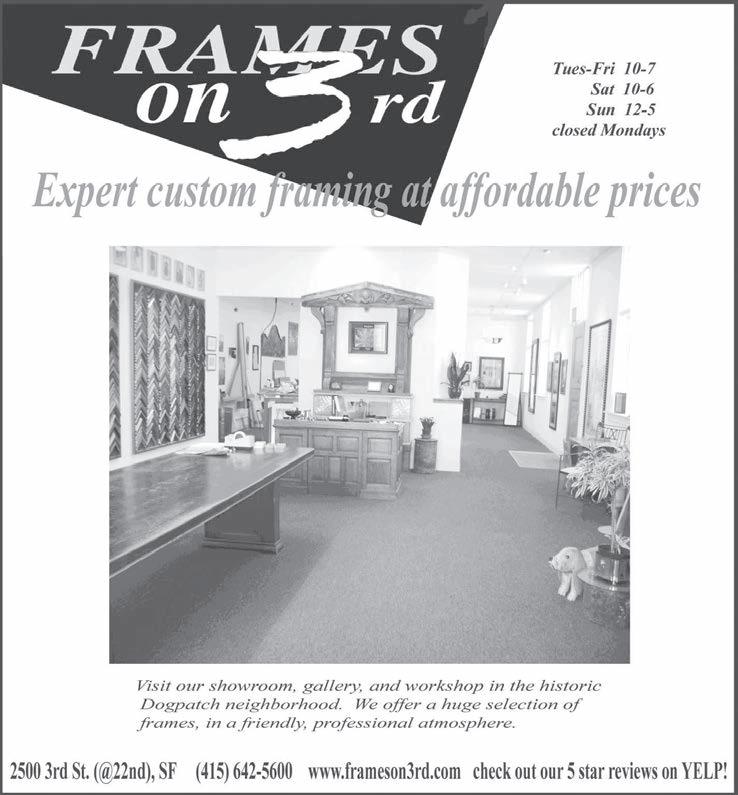

Outreach Advertising
May – June 2014
BUSINESS TAX CHANGE AHEAD
This year San Francisco will phase in a Gross Receipts Tax and reduce the Payroll Expense Tax over the next five years. The Gross Receipts Tax applies to businesses with more than $1 million in San Francisco gross receipts, exempting most small businesses. Business Registration Fees are also changing for all businesses. The City is providing free seminars to inform businesses about these changes the first Thursday of every month at 3pm in the San Francisco Main Public Library Latino Room, 100 Larkin Street. For more information, go to www.sfbiztax.org, call 311 or (415) 701-2311, or contact your tax professional.
INVITATIONS FOR BIDS
The Port of San Francisco, announces an Invitation for Bids for construction on the
PIER 35 BUILDING & ROOF REPAIR
PROJECT, Contract No. 2765, in San Francisco, CA. The proposed Work will consist of modernization and repair of two existing elevators, removal of existing roofing materials, hazardous material abatement, selective dry rot repair to the roof deck, refurbishment of existing historic features including windows, and provision for tenant protection. Estimate for the base bid is $2.25M. Bid documents are available for free download by going to the Port of San Francisco Website at http://www.sfport.com/index.aspx?page=18, where updates will also be posted. Special Site access for facility inspection must be requested through the Project Architect. The LBE subcontracting goal = 19%, and the project is subject to the requirements of the First Source Hiring Program. The Port reserves the right to reject any or all bids and waive any minor irregularities in any bid.
TO BE ELIGIBLE TO BID, the bidding General Contractor (GC) shall possess a valid Class B license from the Contractors State License Board (CSLB), and shall have verifiable experience as specified under Document 00100 of the Bid Documents.
OPTIONAL PREBID CONFERENCE:
5/28/14, 10:30 AM, Port of San Francisco office, Pier 1 at San Francisco, CA 94111.
BIDS DUE: 6/25/14, 1:30 PM. For questions, contact Wendy Proctor (415) 274-0592
ASSESSMENT APPEALS BOARD (AAB)
Notice is hereby given of 6 vacancies on the AAB. Applicants must have at least 5 years experience as one of the following: Certified Public Accountant or Public Accountant; licensed Real Estate Broker; Property Appraiser accredited by a nationally recognized organization, or Property Appraiser certified by the California Office of Real Estate Appraisers. For additional information or to obtain an application, please call 415-554-6778.
FROM THE DEPARTMENT OF THE ENVIRONMENT
Guess what? San Francisco has a website that tells you how and where to recycle almost anything! sfenvironment.org/recyclewhere
Board of Supervisors Regularly
Scheduled Board Meetings June & July 2014
OPEN TO THE PUBLIC –
Come see your San Francisco government in action. Tuesdays, 2:00pm, City Hall Chamber, Room 250.
June 3 June 10 June 17 June 24 July 8 July 15 July 22 July 29
The City and County of San Francisco encourage public outreach. Articles are translated into several languages to provide better public access. The newspaper makes every effort to translate the articles of general interest correctly. No liability is assumed by the City and County of San Francisco or the newspapers for errors and omissions
 BY LISA FAGUNDES, LIBRARIAN
BY LISA FAGUNDES, LIBRARIAN
• Reference Drop-In – One-on-One Help at the Computer: Do you have questions on how to use computers and the internet, how to download eBooks to your device, or how to use the library's databases? Have a reference question that requires more time to answer? A librarian will help answer your toughest conundrums. Wednesdays, June 4, 11, 28, and 25, 6:30 to 7:30 p.m.
• Resume Building Workshop: Create a resume that best communicates your skills and qualifications to prospective employer. In this workshop you’ll learn techniques and gain experience in targeting your resume. Bring your current resume and three to four job descriptions for current positions to which you want to apply. These job descriptions will be used in activities during the workshop. Class limited to 10 people. To sign up, email lisa.fagundes@sfpl.org or call 355.2822. Wednesday, June 4th, 6 to 7:30 p.m.
• Movie Night: The Cup (Phorpa, 1999) – While the soccer World Cup is being played in France, the atmosphere of serene contemplation at a Tibetan monastery is disrupted by soccer fever. Prevented from seeing the Cup finals on television in a nearby village, several young monks plan to rent a TV set for the monastery. The enterprise becomes a test of solidarity, resourcefulness,t and friendship for the students, while the Lama contemplates the challenges
LIBRARY NEWS page 29

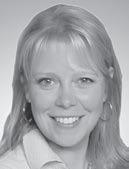
Last month a wavelet of panic roiled Potrero Hill residents after a meatball was discovered at Mississippi and 19th streets. A few days earlier a plate of meatballs with white pills lodged inside, thought to be left to poison a dog, had been found in the Sunset. In that incident, the Sunset resident, who was walking her dog, “took a closer look, and noticed what appeared to be several white pills lodged inside the meatballs,” according to a San Francisco Police Department (SFPD) Taraval Station crime alert. The meatballs were found in the vicinity of 24th Avenue and Ortega.
Police confiscated the meatballs and sent them to their crime lab for testing, which hadn’t been completed before the View went to print. According to police spokesman Albie Esparza, the meatball case is open, though no other dogs in the Sunset have been reported to have ingested suspicious meat.
In the past 12 months police have made no arrests, nor have any suspects in any of the similar incidents in the City, which include meatballs by the dozen found in the Lower Haight, Cole Valley, Hayes Valley, and Bernal Heights, according to a post on Nextdoor Potrero. Earlier this year, the Associated Press reported a dachshund living in either Twin Peaks or Diamond Heights ingested meatballs cooked with rat poison. That dog, named Oskar, died, according to a Nextdoor Potrero post.
CHOCOLATE CAN BE DEADLY TO DOGS, ACCORDING TO THE AMERICAN SOCIETY FOR THE PREVENTION OF CRUELTY TO ANIMALS’ WEBSITE.
The Hill resident's dog lapped the meatball, but didn't chew or swallow it before the owner pried the treat from its jaws. Besides suspicious meatballs, Kansas Street resident Alyssa Landy watched a man leave chocolate cake and pennies near McKinley Park recently.
“I posted [on Nextdoor] about seeing the man who placed down chocolate cake and pennies near McKinley Park,” Landy wrote. Landy called San Francisco's Animal Care and Control office, but Animal Control told her to notify the police. When she contacted SFPD they referred her back to Animal Control. “Nobody came out,” she said, even though she was “able to describe the guy and the location of the cake.” Animal Control was not immediately available for comment about the incident.
Chocolate can be deadly to dogs, according to the American Society for the Prevention of Cruelty to Animals’ website. The darker the chocolate, the more dangerous it is. The ASPCA recommends taking a dog immediately to the veterinarian if it ingests chocolate and shows “more than mild restlessness.” And a post answered by the ASPCA on its website says pennies minted after 1982 are potentially dangerous to dogs. The pennies contain zinc, which can be toxic, causing damage to the animal's kidneys, liver, gastrointestinal tract, and red blood cells.
In the Hill's meatball incident, the resident saw the suspicious food at around 7 p.m., May 8. Later in the evening, police sent a patrol to investigate, but said the meatball didn't fit the same profile as the ones found in the Sunset, which were formed from raw meat. The Hill meatball was cooked. Police didn’t confiscate the meatball; no testing can be done. The resident's dog remains healthy.

KIPP
from page 13
and Girls Club of San Francisco. We have a full-time staff member and a part-time staff member from the Boys and Girls Club on our campus, and they teach electives during the day — this year art and yearbook t— and offer an after-school program at the end of the day.
View: How can community members volunteer or get involved?
Gifford: We have some tutors already from the community who found out about our school; some people came up to us at the Potrero Hill neighborhood festival back in the fall and were really interested in volunteering, so we have a few people come in and tutor students once a week in math or English, that’s the best way right now. We’re always looking for volunteers, and they can just contact us directly at 643.6951.
View: What are some current challenges?
Gifford: Being a brand new school, and for our students is not having a full host of extra-curricular activities or electives to take because we’re so small right now, so we will add these things as we grow, but right now they’re kind of limited.
View: What are some current
strengths?
Gifford: We’re very academically focused. We have really high expectations for our students, both in terms of academics and in terms of character. Those two things really complement each other. We really want our students to have a college-going mindset, so we really try to create a college-going culture here, where everything we do is tied back to this idea of you’re going to go college, be successful, and graduate from college, even when the majority of our students will be the first person in their family to graduate from college. All of the ninth graders take a collegereadiness seminar every day. They do a lot in this class. They do research about different colleges and universities. They have a financial literacy unit to learn about scholarships, grants, and loans. They learn how to do note-taking and annotations, so basically skills that you need in both high school and college.
View: Any last words?

of teaching the word of Buddha in a rapidly changing world. Presented in Dzongkha with English subtitles. Rated G. 93 minutes.Thursday, June 5th, 3 to 5 p.m.
• Musical Performance - Melody of China: This San Francisco-based Chinese chamber ensemble will play traditional Chinese instruments. This program is put on by the Inclusive Programming for Adults with Developmental Disabilities committee. All ages are welcome to join clients from NorCal Vocational to watch this lovely group play. Wednesday, June 18th 1 to 2 p.m.
• The Golden Age of San Francisco Rock, Part 2 – Video Clips: Rock historian Richie Unterberger will show The Golden Age of San Francisco Rock Vol. 2, featuring rare film clips by San Francisco Bay Area folk-rock and psychedelic rock performers from the mid-1960s through the early 1970s. Included will be footage by Jefferson Airplane, Big Brother & the Holding Company with Janis Joplin, Santana, Moby Grape, Country Joe & the Fish, Sly & the Family Stone, Creedence Clearwater Revival, the Grateful Dead, the Beau Brummels, and others. Sunday, June 22nd, 2 to 4 p.m.
• Duct Tape Masterpieces: Join Sophie from Sophie's Stress-Free Soirees for an evening of duct tape fun! Make
a wallet, a pen case, a phone case, or anything else you can dream up! Duct tape rolls will be provided, but feel free to bring your own! For ages nine and up. Thursday June 12th 5:30 to 7:30 p.m.
• Baby Rhyme and Play Time: Songs and rhymes for infants up to 18 months old and their caregiver. Tuesdays, June 3, 10, 17, and 24, 1:15 to 1:45 p.m.
• Family Story time: Featuring stories, songs and rhymes. For children from birth to five years old and their caregiver. Thursdays June 5, 12, 19, and 26, 10:30 to 11 a.m. and 11:15 to 11:45 a.m.
• Fun Flicks: This month’s films are No Roses for Harry; Millions of Cats; Scrambled States of America; Tuesday; and Banjo Frogs. For children three to eight. Bring a snack and enjoy the show. Wednesday June 11, 6:30 to 7:15 p.m.
• Buzzy Bee Travelling Hive: Veteran beekeeper Tim Muhrlin will present a program about the complex behavior of the honey bee – honey tastings included! For children ages three and older. Friday, June 6th, 1:15 to 2:15 p.m.
• Saturday Snacktivity: Join us on the first Saturday of the month for a healthy snack and a fun activity! With food provided by the Potrero Whole Foods, we’ll offer a wholesome snack followed by a craft, Legos, board games, PS3 games, or some other thing to do! We’re open to your suggestions as we launch this new Saturday pro -
gram. Kids, tweens, teens, and parents are welcome. Join us! Saturday, June 7th, 12 to 1:30 p.m.
• Native American Hoop Dancer, Eddie Madril: Yaqui Indian hoop dancer, Edwardo Madril will share the beauty of Native American heritage through dance, music and origin stories. Participants will be introduced to some of the most popular and rare Native American dances. Origins and meanings of the dances will be discussed, and you’ll be invited to join in some traditional dances. For all ages. Friday, June 13th, 1:15 to 2:15 p.m.
• Crafts with the Museum of Craft and Design: Join the Museum of Craft and Design in a drop-in workshop inspired by their current exhibition of works in cardboard, Elevated Corrugated. Cut, bend, tape, glue, and embellish your way to making fun accessories out of cardboard. For children ages six to 12, parental assistance encouraged. Saturday, June 14th, 4 to 5 p.m.
• Musical Theater Workshop with Epiphany Productions: Epiphany Productions teaches theater technique, guiding participants through the enactment of a story, using costume, song, movement, and character. Their focus is on self-expression, self- confidence, fun, and basic performance skills. This workshop is for kindergartners through sixth graders. Friday, June 20th, 1:15 to 2:15 p.m.
• Movie and Meal Day – Frozen: In partnership with the Potrero Hill Family Support Center (PHFSC), we’ll present Frozen and PHFSC will
provide a meal. Friday, June 20th, 3 to 5:30 p.m.
• African Music – Keenan Webster: Come hear the beautiful West African harp (kora) and other instruments of African origin, and play some too! Keenan Webster will play as well as give hands-on demonstrations of various instruments. Dancing encouraged ,if space allows. Bring the whole family. Friday, June 27th, 1:15 to 2:15 p.m.
• Creative Writing Workshop: A free class to help you write your own stories, develop your characters, and find your own unique voice in a supportive and creative environment. Contact Shevi for more information: sheviros@ gmail.com or 602.7961. Thursdays June 5, 12, 19, and 26, 12:30 to 2:30 p.m.
• The Potrero Hill Book Club: Meets at the library every third Wednesday of the month. This month’s selection is The Painted Veil by M. Somerset Maugham. Join the discussion!
Wednesday June 18th, 7 to 8:00 p.m.
• Potrero Branch Seed Library: Thanks to the generous contributions of local gardeners and Whole Foods Grocery, Potrero Branch Seed Library continues. You’re welcome to “check out” seeds, plant them, and bring your harvested seeds back to the library. Without your support, the Seed Library would not exist. We need your seeds to share with the community!


Bayview Police Station Captain’s Community Meeting is held on the first Tuesday of each month at the Bayview Station, 201 Williams Avenue. Next meeting: June 2nd, 6 p.m.
Dogpatch Neighborhood Association usually meets the second Tuesday of each odd-numbered month. Next meeting: July 8th, 7 p.m. Voting membership is open to anyone living in or owning property or a business in Dogpatch. For more information or to join/pay online: mydogpatch.org.
Friends of Franklin Square Join the Friends of Franklin Square to help improve our local park! We need your ideas and input to update the master plan and to help seek grant money to improve the park. Concerned about park safety and cleanliness? Want the soccer field to be re-carpeted? Interested in getting a dog-friendly area built? Now is your chance to make it happen! Meet your neighbors and share ideas. Free snacks and drinks provided. We will also have a mini-trivia contest with prizes from our neighborhood businesses! For more information contact: friendsoffranklinsquare@gmail.com.
McKinley Square Community Group is a communication and discussion group regarding events and activities, clean-up days, improvement and beautification, and other concerns such as crime in the neighborhood. MSCA board meets approximately quarterly on the second Wednesday of the month. Look to the online discussion group for postings of upcoming meetings: groups.yahoo.com/group/McKinleySquareCommunity. Locations vary between the Potrero Hill Neighborhood House and Downtown High School. For updates, including sustainable gardening and park workdays, and our grant progress, check out the MSCA blog at: mckinleysquareblog. blogspot.com.
Potrero Boosters Neighborhood Asosociation meets the last Tuesday of each month at 7 p.m. (social time begins at 6:45 p.m.) in the wheelchair-accessible Potrero Hill Neighborhood House, 953 De Haro Street. For more information: potreroboosters.org or email president@ potreroboosters.org. Next meeting: June 24th, 7 p.m.
Potrero Dogpatch Merchants Association meets the second Tuesday of each month at 10 a.m. at Goat Hill Pizza, corner of Connecticut and 18th streets. Visit potrerohill.biz or call 341.8949. Next meeting: June 10th, 10 a.m.
Potrero Hill Democratic Club meets the first Tuesday of each month at 7 p.m. at the Potrero Hill Neighborhood House, 953 De Haro Street. For more information: 648.6740, PHDemClub.org. Next meeting: June 3rd, 7 p.m.
Potrero Hill Garden Club usually meets the last Sunday of the month at 11 a.m. for a potluck lunch in a local home or garden. Discussions are held on organic, edible, or ornamental gardening appropriate for Potrero Hill’s microclimate. Call 648.1926 for details.
Pennsylvania Street Gardens has volunteer workdays the first Saturday of every month from 10 a.m. to noon. We meet at Pennsylvania Garden, 251 Pennsylvania Avenue, and provide all the necessary tools and training. We’d love to see you at the gardens. For more information visit our website psgsf.org or email Emily at emily@psgsf.org. Next volunteer days: June 7th, July 5th.
Starr King Open Space SKOS Stewardship day is Saturday, June 14th from 9:30 a.m. to 12:30 p.m. – come volunteer to help maintain the land. The Starr King Open Space Board Meeting is on Monday June 16 from 6 to 7:30 PM in the meeting room of the Public Potrero Branch Library. Thank you for your continued donations and support, for more information: webiste starrkingopenspace.org, email starrkingboard@ gmail.com, or voicemail 633.6756.
There goes (here comes) the neighborhood

Food
WANT TO DO HOME CHEESEMAKING—LOOKING FOR A PARTNER Hi – I have wanted to learn at home cheese–making and think maybe it would be better to have someone to learn it along with me. Interested in pressed cheeses. I can provide all equipment and refrigerators. If you are interested please send me an email at daherron@yahoo.com. I live on Missouri Street. Thanks.
CARPENTRY & PAINTING also: plumbing, seismic/structural work, stucco, roof repairs & gutter cleaning, tree trimming. www.FarWestConstr.com Jim Kennedy, 415-276-1990. Ca. Lic. 751689.
TOM’S PLUMBING Tom has been satisfying Potrero Hill customers for over 30 years. All plumbing needs handled promptly and efficiently at a very low cost. Keep it local and call Tom! 415-824-3538.
PROFESSIONAL ORGANIZER A decade’s experience transforming chaot-
ic spaces into calm, conducive environments. Meticulous, patient, creative. EVA: yolka.palka@gmail.com or 415-666-5072.
HANDYMAN EXTRAORDINAIRE! 20 years experience - Repair Remodeling Elec Plumbing Drains Light Fix. DOORS! Windows Cabinets Decks Staircases Built. $45-55/hr mike@trivelocarpentry.com. Mike 415-308-2380.
Housekeeping
CLEANING PROFESSIONAL 28 Years Experience. Apartments, Homes or Offices and Apartment Buildings. Roger Miller 415-794-4411. References.
COMPUTER PROBLEMS DRIVING YOU BUGGY? Problems xed! 25 years of industry experience. Personal IT consulting to small businesses or busy professionals. We can install and/or help shop for computer/network/printer or setup/troubleshoot wireless networks. If you’re not technical, don’t worry - we are. Rob 415244-3305. rob@sfcomputech.com.


